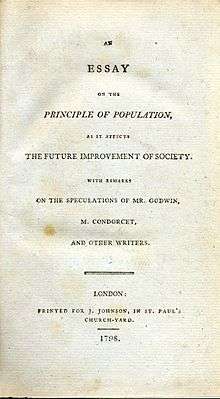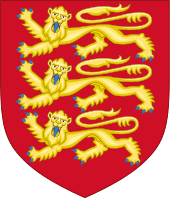List of English inventions and discoveries
English inventions and discoveries are objects, processes or techniques invented, innovated or discovered, partially or entirely, in England by a person from England (that is, someone born in England – including to non-English parents – or born abroad with at least one English parent and who had the majority of their education or career in England). Often, things discovered for the first time are also called inventions and in many cases, there is no clear line between the two. Nonetheless, science and technology in England continued to develop rapidly in absolute terms. Furthermore, according to a Japanese research firm, over 40% of the world’s inventions and discoveries were made in the UK, followed by France with 24% of the world’s inventions and discoveries made in France and followed by the US with 20%.[1]
| Culture of England |
|---|
 |
| History |
| People |
| Languages |
|
Traditions
|
|
Mythology and folklore
|
| Cuisine |
| Religion |
| Art |
| Literature |
|
Music and performing arts
|
|
Media
|
|
Monuments
|
|
The following is a list of inventions, innovations or discoveries known or generally recognised to be English.
Agriculture
.jpg)
- 1627: Publication of first experiments in Water desalination and filtration by Sir Francis Bacon (1561–1626).[2]
- 1701: Seed drill improved by Jethro Tull (1674–1741).
- 18th century: of the horse-drawn hoe and scarifier by Jethro Tull[3][4][5]
- 1780s: Selective breeding and artificial selection pioneered by Robert Bakewell (1725–1795).[6]
- 1842: Superphosphate or chemical fertilizer developed by John Bennet Lawes (1814–1900).[7]
- 1850s: Steam-driven ploughing engine invented by John Fowler (1826–1864).[8]
- 1901: First commercially successful light farm-tractor invented by Dan Albone (1860–1906).[9]
- 1930s onwards: Developments in dairy farming systems pioneered by Rex Paterson (1902–1978).[10]
Ceramics
- 1748: Fine porcelain developed by Thomas Frye (c. 1710–1762), of Bow porcelain factory, London.[11] Cf. Frye's rivals at Chelsea porcelain factory.
- 1770s: Jasperware developed by Josiah Wedgwood (1730–1795).[12]
- 1789–1793: Bone china created by Josiah Spode (1733–1797).[13]
- 1813: Ironstone china invented by Charles James Mason (1791–1856).[14]
Clock making
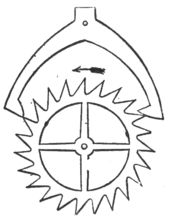
- Anglo-Saxon times: type of candle clock invented by Alfred the Great (849–899).[15]
- c. 1657: Anchor escapement probably invented by Robert Hooke (1635–1703).[16]
- c. 1657: Balance spring added to balance wheel by Robert Hooke (1635–1703).[17][18]
- c. 1722: Grasshopper escapement invented by John Harrison (1693–1776); Harrison created the H1, H2, H3 & H4 watches (to solve the longitude measurement problem).[19]
- c. 1726: Gridiron pendulum invented by John Harrison (1693–1776).[18]
- c. 1755: Lever escapement, the greatest single improvement ever applied to pocket watches, invented by Thomas Mudge (1715–1794).[18]
- 1761: First true Marine chronometer perfected by John Harrison (1693–1776).[18]
- 1923: Self-winding watch invented by John Harwood (1893–1964).[20]
- 1955: First accurate atomic clock invented by Louis Essen (1908–1997).[21]
- 1976: Coaxial escapement mechanism invented by George Daniels (1926–2011).
Clothing manufacturing
- 1589: The stocking frame, a mechanical knitting machine used in the textiles industry, invented by William Lee (1563–1614).
- 1733: The flying shuttle, a key development in the industrialization of weaving during the early Industrial Revolution, invented by John Kay of Walmersley (1704-c. 1779).

- 1759: The Derby Rib machine (for stocking manufacture) invented by Jedediah Strutt (1726–1797).[22]
- 1764: The spinning jenny invented by James Hargreaves (c. 1720–1778).
- 1767: Spinning frame invented by John Kay of Warrington.
- 1769: The water frame, a water-powered spinning frame, developed by Richard Arkwright (1732–1792).
- 1775–1779: Spinning mule invented by Samuel Crompton (1753–1827).
- 1784: Power loom invented by Edmund Cartwright (1743–1823).
- 1790: Sewing machine invented by Thomas Saint.[23]
- 1808: The bobbinet, a development on the warp-loom, invented by John Heathcoat (1783–1861).
- 1856: Mauveine, the first synthetic organic dye, discovered by William Henry Perkin (1838–1907).
- 1941: Polyester invented by John Rex Whinfield (1901–1966).
Communications
- Pre-1565: The pencil invented in Seathwaite, Borrowdale, Cumbria, using Grey Knotts graphite.
- 1588: Modern shorthand invented by Timothy Bright (1551?–1615).
- 1661: The postmark (called the "Bishop Mark") introduced by English Postmaster General Henry Bishop (1611–1691/2).[24]
- 1667: Tin can telephone, a device that conveyed sounds over an extended wire by mechanical vibrations, invented by Robert Hooke (1635–1703).[25]
- 1714: Patent for an apparatus regarded as the first typewriter granted to Henry Mill (c. 1683–1771).[26]
- 18th century: The Valentine's card first popularised.[27]
- 1822: The mechanical pencil patented by Sampson Mordan (1790–1843) and John Isaac Hawkins (1772–1855).[28]
- 1831: Electromagnetic induction & Faraday's law of induction. Began as a series of experiments by Michael Faraday (1791–1867); later became some of the first experiments in the discovery of radio waves and the development of radio.[29]
- 1837: The first commercially successful electric telegraph developed by Sir Charles Wheatstone (1802–1875) and Sir William Fothergill Cooke (1806–1879).[30][31][32]
- 1837: Pitman Shorthand invented by Isaac Pitman (1813–1897).
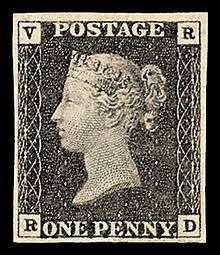
- 1840: Uniform Penny Post and postage stamp invented by Sir Rowland Hill (1795–1879).[33]
- 1843: The Christmas card introduced commercially by Sir Henry Cole (1808–1882).[34]
- 1873: Discovery of the photoconductivity of the element selenium by Willoughby Smith (1828–1891). Smith's work led to the invention of photoelectric cells (solar panels), including those used in the earliest television systems.
- 1879: The first radio transmission, using a spark-gap transmitter (achieving a range of approximately 500 metres), made by David E. Hughes (1831–1900).
- 1888: The world's first moving picture film produced by Louis Le Prince (1841 – vanished 16 September 1890) of Roundhay Garden, Leeds Bridge.
- 1897: The world's first radio station was located at The Needles Batteries on the western tip of the Isle of Wight; it was set up by Marconi.[35][36]
- 1899: The world's first colour motion picture film produced by Edward Raymond Turner (1873–1903).
- 1902: Proposition by Oliver Heaviside (1850–1925) of the existence of the Kennelly–Heaviside layer, a layer of ionised gas that reflects radio waves around the Earth's curvature.
- 1912: Development of radio communication pioneered by William Eccles (1875–1966).
- 1914: The world's first automatic totalisator invented by English-born George Julius (1873–1946).
- 2 December 1922: Mechanical scanning device (a precursor to modern television) demonstrated in Sorbonne, France by Englishman Edwin Belin.
- 1930: The Plessey company in England began manufacturing the Baird Televisor receiver: the first television receiver sold to the public.
- 1931: Stereophonic sound or, more commonly, stereo invented at EMI in Hayes, Middlesex by Alan Blumlein (1903–1942).[37]
- 1933: The 405-line television system (the first fully electronic television system used in regular broadcasting) developed at EMI in Hayes, Middlesex by Alan Blumlein (1903–1942), under the supervision of Sir Isaac Shoenberg.
- 1936: The world's first regular public broadcasts of high-definition television began from Alexandra Palace, North London by the BBC Television Service.
- 1930s: Radar pioneered at Bawdsey Manor by Scotsman Robert Watson-Watt (1892–1973) and Englishman Henry Tizard (1885–1939).
- 1945: The concept of geostationary satellites for the use of telecommunications relays popularised by Arthur C. Clarke (1917–2008).
- 1964 onwards: Use of fibre optics in telecommunications pioneered by Englishman George Hockham (1938–2013) and Chinese-born Charles K. Kao.
- Late 1960s: Development of the long-lasting materials that made liquid crystal displays possible. Team headed by Sir Brynmor Jones; developed by Scotsman George Gray and Englishman Ken Harrison in conjunction with the Royal Radar Establishment and the University of Hull, who ultimately discovered the crystals used in LCDs.[38]
- 1970: The MTV-1, the first near pocket-sized handheld television, developed by Sir Clive Sinclair (born 1940).
- 1973: First transmissions of the Teletext information service made by the British Broadcasting Corporation.
- 1992: Clockwork radio invented by Trevor Baylis (1937–2018).[39]
- 3 December 1992: The world's first text/SMS message ("Merry Christmas") sent over the Vodafone GSM network by Neil Papworth (born 1969).
- 2016: Holographic TV device created by the BBC.[40]
Computing

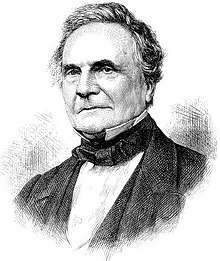
- 1822: The Difference Engine, an automatic mechanical calculator designed to tabulate polynomial functions, proposed by Charles Babbage (1791–1871).[41]
- 1837: The Analytical Engine, a proposed mechanical general-purpose computer, designed by Charles Babbage (1791–1871).[41]
- 1842: The person regarded as the first computer programmer was Ada Lovelace (1815–1852), only legitimate child of the poet Byron and his wife Anne Isabella Milbanke, Baroness Wentworth.[42][43][44][45]
- 1842: First programming language, the Analytical Engine order code, produced by Charles Babbage (1791–1871) and Ada Lovelace (1815–1852).
- 1854: Boolean algebra, the basis for digital logic, conceived by George Boole (1815–1864).
- 1912: Argo system, the world's first electrically powered mechanical analogue computer, invented by Arthur Pollen (1866–1937).
- 1918: The flip-flop circuit, which became the basis of electronic memory (Random-access memory) in computers, invented by William Eccles (1875–1966) and F. W. Jordan (1882–?).
- 1936–1937: The Universal Turing machine invented by Alan Turing (1912–1954).[46] The UTM is considered to be the origin of the stored programme computer used in 1946 for the "Electronic Computing Instrument" that now bears John von Neumann's name: the Von Neumann architecture.
- 1939: The Bombe, a device used by the British to decipher German secret messages during World War II, invented by Alan Turing (1912–1954).[46]
- 1943–1944: The Colossus computer – the world's first programmable, electronic, digital computer – invented by Tommy Flowers (1905–1988).[47]
- 1946–1950: ACE and Pilot ACE invented by Alan Turing (1912–1954).[46]
- 1946–1947: The Williams tube, a cathode ray tube used to store electronically (500 to 1,000 bits of) binary data, developed by Frederic Calland Williams (1911–1977) and Tom Kilburn (1921–2001).
- 1948: The Manchester Baby – the world's first electronic stored-programme computer – built by Frederic Calland Williams (1911–1977) and Tom Kilburn (1921–2001) at the Victoria University of Manchester.[48]
- 1949: The Manchester Mark 1 computer developed by Frederic Calland Williams (1911–1977) and Tom Kilburn (1921–2001); historically significant because of its pioneering inclusion of index registers.
- 1949: EDSAC – the first complete, fully functional computer inspired by the von Neumann architecture, the basis of every modern computer – constructed by Maurice Wilkes (1913–2010).
- Late 1940s/early 1950s: The integrated circuit, commonly called the microchip, conceptualised and built by Geoffrey Dummer (1909–2002).
- February 1951: The Ferranti Mark 1 (a.k.a. the Manchester Electronic Computer), the world's first successful commercially available general-purpose electronic computer, invented by Frederic Calland Williams (1911–1977) and Tom Kilburn (1921–2001).
- 1951: The first known recordings of computer generated music played on the Ferranti Mark 1 computer using a programme designed by Christopher Strachey (1916–1975).
- 1951: LEO made history by running the first business application (payroll system) on an electronic computer for J. Lyons and Co. Under the advice of Maurice Wilkes (1913–2010), LEO was designed by John Pinkerton (1919–1997) and David Caminer (1915–2008).
- 1951: Concept of microprogramming developed by Maurice Wilkes (1913–2010) from the realisation that the Central Processing Unit (CPU) of a computer could be controlled by a miniature, highly specialised computer programme in high-speed ROM.
- 1952: Autocode developed by Alick Glennie (1925–2003) for the Manchester Mark 1 computer; Autocode is regarded as the first computer compiler.
- 1952: The first graphical computer game, OXO or Noughts and Crosses, programmed on the EDSAC at Cambridge University as part of a Ph.D. thesis by A.S. Douglas (1921–2010).
- 1952: First trackball built by Tom Cranston, Fred Longstaff and Kenyon Taylor (1908–1996); invented 1947 by Ralph Benjamin.
- 1956 onwards: Metrovick 950, the first commercial transistor computer, built by the Metropolitan-Vickers Company of Manchester.
- 1958: EDSAC 2, the first computer to have a microprogrammed (Microcode) control unit and a bit slice hardware architecture, developed by a team headed by Maurice Wilkes (1913–2010).
- 1961: The Sumlock ANITA calculator, the world's first all-electronic desktop calculator, designed and built by the Bell Punch Company of Uxbridge.
- 1962: The Atlas Computer – arguably the world's first supercomputer, and fastest computer in the world until the American CDC 6600 – developed by a team headed by Tom Kilburn (1921–2001). Introduced modern architectural concepts: spooling, interrupts, pipelining, interleaved memory, virtual memory, and paging.
- Late 1960s: Denotational semantics originated in the work of Christopher Strachey (1916–1975), a pioneer in programming language design.
- 1970: Packet switching co-invented by Welsh engineer Donald Davies (1924–2000) and Polish-born Paul Baran; it was Davies who coined the term packet switching at the National Physical Laboratory in London.
- 1972: The Sinclair Executive, the world's first small electronic pocket calculator, produced by Sir Clive Sinclair (born 1940).
- 1979: The first laptop computer, the GRiD Compass, designed by Bill Moggridge (1943–2012).
- 1979: Digital audio player (MP3 Player) invented by Kane Kramer (born 1956). His first investor was Sir Paul McCartney.
- 1980–1982: Home computers the Sinclair ZX80, ZX81 and ZX Spectrum produced by Sir Clive Sinclair (born 1940).
- 1981: The Osborne 1 – the first commercially successful portable computer, precursor to the laptop computer – developed by English-American Adam Osborne (1939–2003).
- 1982: 3D Monster Maze, widely considered the first survival horror computer game, developed from an idea by J. K. Greye and programmed by Malcolm Evans (b. 1944).
- 1984: The world's first pocket computer, the (Psion Organiser), launched by London-based Psion PLC.
- 1984: Elite, the world's first computer game with 3D graphics, developed by David Braben (born 1964) and Ian Bell (born 1962).
- 1985: ARM architecture introduced by Cambridge computer manufacturer Acorn Computers; the ARM CPU design is the microprocessor architecture of 98% of mobile phones and every smartphone.[49]
- 1989: World Wide Web invented by Sir Tim Berners-Lee (born 1955).[50]
- 1989: HTTP application protocol and HTML markup language developed by Sir Tim Berners-Lee (born 1955).
- 1989: Launch of the first PC-compatible palmtop computer, the (Atari Portfolio), designed by Ian H. S. Cullimore.
- 1989: First touchpad pointing device developed for London-based Psion PLC's Psion MC 200/400/600/WORD Series.
- 1990: The world's first web browser invented by Sir Tim Berners-Lee (born 1955). Initially called WorldWideWeb, it ran on the NeXTSTEP platform, and was renamed Nexus in order to avoid confusion with the World Wide Web.
- 1991 onwards: The Linux kernel developed by English-born Andrew Morton (born 1959) and Alan Cox (born 1968).
- 2002: Wolfram's 2-state 3-symbol Turing machine proposed by London-born Stephen Wolfram (born 1959).
- 2012: Launch of the Raspberry Pi, a modern single-board computer for education, designed and built by Cambridgeshire-based charity Raspberry Pi Foundation.[51]

Criminology
- 1836: Marsh test (used for detecting arsenic poisoning) invented by James Marsh (1794–1846).
- 1888–1895: Fingerprint classification method developed by Sir Francis Galton (1822–1911); a breakthrough in forensic science.
- 1910: First use of wireless telegraphy in the arrest of a criminal, Dr Crippen.[52]
- 1984: DNA fingerprints are discovered by Alec Jeffreys (born 1950).[53]
- 1987: Process of DNA profiling developed by Alec Jeffreys (born 1950).[53]
- 1991: Iris recognition algorithm invented by Swede John Daugman working at the University of Cambridge.
- 1995: World's first national flop DNA database developed: National DNA Database.
Cryptography
- 1605: Bacon's cipher devised by Sir Francis Bacon (1561–1626).
- 1854: The Playfair cipher, the first literal digraph substitution cipher, invented by Charles Wheatstone (1802–1875).[32]
- 1941: Codebreaker Bill Tutte (1917–2002) developed the Cryptanalysis of the Lorenz cipher, which Hitler used to communicate with his generals in World War II.
- 1973: Clifford Cocks (born 1950) first developed what came to be known as the RSA cipher at GCHQ, approximately three years before it was rediscovered by Rivest, Shamir, and Adleman at MIT.[54]
Engineering
- 1600: The first electrical measuring instrument, the electroscope, invented by William Gilbert (1544–1603).
- 1676–1678: First working universal joint devised by Robert Hooke (1635–1703).
- 1698: First working steam pump invented by Thomas Savery (c. 1650–1715).[55]
- 1709: First coke-consuming blast furnace developed by Abraham Darby I (1678–1717).[55]

- 1712: Atmospheric steam engine invented by Thomas Newcomen (1664–1729).[55][56]
- 1739: Screw-cutting lathe invented by Henry Hindley (1701–1771).
- 1770s: Continuous track first conceived by Anglo-Irish Richard Lovell Edgeworth (1744–1817).[57]
- 1780: Modified version of the Newcomen engine (the Pickard engine) developed by James Pickard (dates unknown).
- 1781: The Iron Bridge, the first metal bridge, cast and built by Abraham Darby III (1750–1789).[55]
- 1791: The first true gas turbine invented by John Barber (1734–1801).
- 1796–97: The first iron-framed building (and therefore forerunner of the skyscraper) – Ditherington Flax Mill in Shrewsbury, Shropshire – built by Charles Bage (1751–1822).
- 1800: First industrially practical screw-cutting lathe developed by Henry Maudslay (1771–1831).
- 1806: The Fourdrinier machine, a papermaking machine, invented by Henry Fourdrinier (1766–1854).
- 1823: First internal combustion engine to be applied industrially patented by Samuel Brown (?–1849).
- 1826: Continuous track (under the name "universal railway") patented by Sir George Cayley (1773–1857).
- 1830: First (toroidal, closed-core) electric transformer invented by Michael Faraday (1791–1867).[58]
- 1831: First Electrical generator (or dynamo), the Faraday disk, invented by Michael Faraday.[58]
- 1834–1878: Water and sewerage systems for over thirty cities across Europe designed by William Lindley (1808–1900).
- 1840s: The linear motor, a multi-phase alternating current (AC) electric motor, proposed by Charles Wheatstone (1802–1875); 1940s: developed by Eric Laithwaite (1921–1997).[32]
.jpg)
- 1841: Widely accepted standard for screw threads devised by Joseph Whitworth (1803–1887).
- 1842: The adjustable spanner invented by Edwin Beard Budding (1796–1846).
- 1845: Hydraulic crane developed by William Armstrong (1810–1900); in 1863, Armstrong also built the first house in the world powered by hydroelectricity, at Cragside, Northumberland.
- 1846: The first fireproof warehousing complex – Albert Dock, Liverpool – designed by Jesse Hartley (1780–1860).
- 1848: The Francis turbine developed by James B. Francis (1815–1892), born near Witney, Oxfordshire.
- 1868: First commercial steel alloy produced by Robert Forester Mushet (1811–1891).
- 1869–1875: Crookes tube, the first cathode ray tube, invented by William Crookes (1832–1919).[55]
- 1871: First enclosed wind tunnel invented, designed and operated by Francis Herbert Wenham (1824–1908).[18]
- 1872: The Carey Foster bridge, a type of bridge circuit, invented by Carey Foster (1835–1919).[59]
- 1880–1883: The Wimshurst machine, an Electrostatic generator for producing high voltages, developed by James Wimshurst (1832–1903).
- 1884: Steam turbine invented by Charles Algernon Parsons (1854–1913).[55]
- 1885: Compression ignition engine (a.k.a. the diesel engine) invented by Herbert Akroyd Stuart (1864–1927).
- 1886: Prototype hot bulb engine or heavy oil engine built by Herbert Akroyd Stuart (1864–1927).
- 1889: Two-stroke engine invented by Joseph Day (1855–1946).
- 1890: Opening of the Forth Bridge – monumental cantilever railway bridge, and icon of Scotland – designed and engineered by English civil engineers Benjamin Baker (1840–1907) and John Fowler (1817–1898).
- 1902: Disc brakes patented by Frederick W. Lanchester (1868–1946).[55]
- 1904: Vacuum tube (or valve) invented by John Ambrose Fleming (1849–1945).
- 1907: First reported observation of electroluminescence from a diode by H. J. Round (1881–1966); Round's discovery led to the creation of the light-emitting diode.
- 1917 onwards: Radio guidance systems pioneered by Archibald Low (1888–1956).
- 1935: Arnold Frederic Wilkins (1907–1985) contributed to the development of radar.
- 1940: Cavity magnetron improved by John Randall (1905–1984) and Harry Boot (1917–1983); consequently a critical component in microwave ovens and some radar.[60]
- Late-1940s/early 1950s: The microchip invented by Geoffrey W.A. Dummer (1909–2002).
- 1963: High strength carbon fibre invented at the Royal Aircraft Establishment in 1963. January 1969: Carr Reinforcements (Stockport, England) wove the first carbon fibre fabric in the world.
- 2007: The RepRap Project, the first self-replicating 3D Printer, developed at the University of Bath.
Household appliances
.png)
- 13th century: Magnifying glass defined by Roger Bacon (c.?1214-c.?1292).
- Before 1596: Modern flushing toilet invented by John Harington (1560–1612).[61] The term 'John', used particularly in the US, is generally accepted as a direct reference to its inventor.[62]
- 1733: Perambulator developed by William Kent (c. 1685–1748).[63]
- 1780: First mass-produced toothbrush produced by William Addis (1734–1808).[64][65]
- 1795: First corkscrew patent granted to the Reverend Samuel Henshall (1764?–1807).
- 1810: Tin can for food preservation patented by merchant Peter Durand (dates not known).
- 1818: Modern fire extinguisher invented by George William Manby (1765–1854).[63]
- 1828: Thermosiphon, which forms the basis of most modern central heating systems, invented by Thomas Fowler (1777–1843).
- 1830: Lawn mower invented by Edwin Beard Budding (1796–1846).[66]
- 1836: The Daniell cell – a type of electrochemical cell; an element of an electric battery – invented by John Frederic Daniell (1790–1845).[67]
- 1840: Postage stamp invented by Sir Rowland Hill (1795–1879).[33]
- 1845: Rubber band patented by inventor Stephen Perry (dates not known).[68]
- 1878: Incandescent light bulb invented by Joseph Wilson Swan (1828–1914).[69][70]
- 1884: Light switch invented by John Henry Holmes (dates not known) in Shieldfield.
- 1899: Little Nipper Mouse trap invented by James Henry Atkinson (1849–1942).
- Late-19th century: Commercially produced electric toaster developed by R. E. B. Crompton (1845–1940).
- Late-19th century: Modern pay toilet invented by John Nevil Maskelyne (1839–1917); Maskelyne invented a lock for London toilets, which required a penny to operate, hence the euphemism "spend a penny".
- 1901: First powered vacuum cleaner invented by Hubert Cecil Booth (1871–1955).[71][72][73]
- Before 1902: First practical Teasmade designed by clockmaker Albert E. Richardson (dates not known) of Ashton-under-Lyne.
- Before 1920: Folding carton invented by Charles Henry Foyle (died 1948).
- 1924: First modern dishwasher invented by William Howard Livens (1889–1964)[74]
- 1955: First fully automatic electric kettle produced by manufacturer Russell Hobbs of Failsworth, Greater Manchester.
- 1963: Lava lamp invented by accountant Edward Craven Walker.
- 1965: Collapsible baby buggy produced by Owen Finlay Maclaren (1907–1978).
- 1983: "Bagless" vacuum cleaner invented by James Dyson (born 1947).[75]
Industrial processes
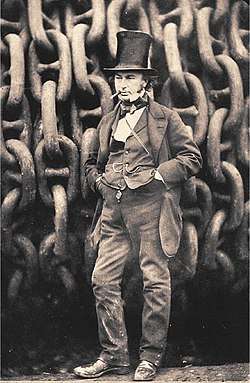
- 1740: English crucible steel developed by Benjamin Huntsman (1704–1776).
- 1743: Sheffield plate, a layered combination of silver and copper, invented by Thomas Boulsover (1705–1788).
- 1746: The lead chamber process, for producing sulfuric acid in large quantities, invented by John Roebuck (1718–1794).
- c. 1760-c. 1840: Pioneers of the Industrial Revolution – Isambard Kingdom Brunel (1806–1859); Abraham Darby I (1678–1717); Abraham Darby II (1711–1763); Abraham Darby III (1750–1789); Robert Forester Mushet (1811–1891).
- 1769: The water frame, a water-powered spinning frame, invented by Richard Arkwright (1732–1792).
- c. 1770: Coade stone, a high quality stoneware, created by Eleanor Coade (1733–1821).
- 1784–1789: Power loom developed by Edmund Cartwright (1743–1823).
- 1795: Hydraulic press invented by Joseph Bramah (1748–1814).
- 1820: The Rubber Masticator, a machine for recycling rubber, invented by Thomas Hancock (1786–1865).
- 1824: Portland cement patented by Joseph Aspdin (1778–1855).
- 1840: Electroplating process patented by George Elkington (1801–1865).
- 1843: Vulcanisation of rubber, a process for making natural rubber more durable, patented by Thomas Hancock (1786–1865).
- 1850: The Parkes process, for removing silver from lead during the production of bullion, invented by Alexander Parkes (1813–1890).
- 1850–1855: Steel production Bessemer process developed by Henry Bessemer (1813–1898).
- 1862: First man-made plastic – Nitrocellulose, branded Parkesine – invented by Alexander Parkes (1813–1890).
- 1912: Stainless steel invented by Harry Brearley (1871–1948).
- 1933: First industrially practical polythene discovered by accident in 1933 by Eric Fawcett and Reginald Gibson in Northwich.
- 1952: The float glass process, for the manufacture of high-quality flat glass, invented by Alastair Pilkington (1920–1995).
- 1950s: The Wilson Yarn Clearer developed by inventor Peter Wilson (dates not known).
- 2001: Self-cleaning glass is developed by Pilkington.
Medicine
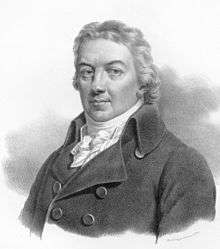
- Anglo-Saxon times: The earliest pharmacopoeia in English (Cotton Vitellius, MS C. iii).[76]
- 1628: First correct description of circulation of the blood in De Motu Cordis by William Harvey (1578–1657).[77]
- 18th century: Invention of surgical forceps attributed to Stephen Hales (1677–1761).[78]
- c. 1711: First blood pressure measurement and first cardiac catheterisation by Stephen Hales (1677–1761).[79]
- 1763: Aspirin's active ingredient discovered by Edward Stone (1702–1768).
- 1770s: Isolation of fibrin, a key protein in the blood coagulation process; investigation of the structure of the lymphatic system; and description of red blood cells by surgeon William Hewson (1739–1774), so-called "father of haematology".
- 1775: First demonstration that a cancer may be caused by an environmental carcinogen by Percivall Pott (1714–1788), also a founding father of orthopedy.[80]
- 1794: Colour blindness first described in a paper titled "Extraordinary facts relating to the vision of colours" by John Dalton (1766–1844).[81]
- 1798: Smallpox vaccine, the first successful vaccine to be developed, invented by Edward Jenner (1749–1823); in so doing, Jenner is said to have "saved more lives [. . .] than were lost in all the wars of mankind since the beginning of recorded history."[82][83]
- 1800: Anaesthetic properties of nitrous oxide (entonox/"laughing gas") discovered by Humphry Davy (1778–1829).[84]
- 1817: First description of (what would come to be called) Parkinson's disease in "An Essay on the Shaking Palsy" by James Parkinson (1755–1824).[85]
- 1818 or 1829: First successful blood transfusion performed by James Blundell (1791–1878).[86]
- 1819: First accurate description of hay fever by John Bostock (1773–1846).[87]
- 1847: Ophthalmoscope conceived by Charles Babbage (1791–1871).[78]
- 1850s: Location of the source of cholera by pioneer of anaesthesia and "father of epidemiology" John Snow (1813–1858).[88]
- 1850s: General anaesthetic pioneered by Englishman John Snow (1813–1858) and Scotsman James Young Simpson.[88]
- 1850s onwards: Treatment of epilepsy pioneered by Edward Henry Sieveking (1816–1904).
- 1858: First publication of Gray's Anatomy, widely regarded as the first complete human-anatomy textbook, by Henry Gray (1827–1861).
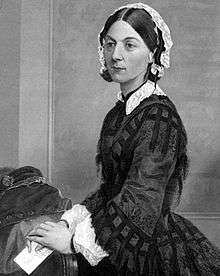
- 1860 onwards: Modern nursing pioneered by Florence Nightingale (1820–1910).
- 1867: Antisepsis in surgery invented by Joseph Lister (1827–1912).
- 1867: Clinical thermometer devised by Thomas Clifford Allbutt (1836–1925).[89]
- 1887: First practical ECG machine invented by Augustus Waller of St Mary's Hospital in London.[90]
- 1898: The mosquito identified as the carrier of malaria by Sir Ronald Ross (1857–1932).
- 1901: Amino acid Tryptophan discovered by Frederick Gowland Hopkins (1861–1947).
- 1902: First typhoid vaccine developed by Almroth Wright (1861–1947).[91]
- 1912: Vitamins discovered by Frederick Gowland Hopkins (1861–1947).
- 1915: Acetylcholine (ACh) identified by Sir Henry Hallett Dale (1875–1968) for its action on heart tissue.
- 1937 onwards: Protein crystallography developed by Dorothy Crowfoot Hodgkin (1910–1994); Hodgkin solved the structures of cholesterol (1937), penicillin (1946), and vitamin B12 (1956), for which she was awarded the Nobel Prize in Chemistry in 1964; in 1969, she succeeded in solving the structure of insulin, on which she worked for over thirty years.[92]
- 1937: Discovery of the Citric acid cycle ("Krebs Cycle") by German-born (naturalised) British physician and biochemist Hans Adolf Krebs (1900–1981) at the University of Sheffield.
- 1940s: Groundbreaking research on the use of penicillin in the treatment of venereal disease carried out in London by Jack Suchet (1908–2001) with Scottish scientist Sir Alexander Fleming.
- 1941: Crucial first steps in the mass production of penicillin made by Norman Heatley (1911–2004).
- 1949: Diagnostic ultrasound first used to assess the thickness of bowel tissue by English-born physicist John J. Wild (1914–2009), so-called "father of medical ultrasound".[93]
- 1949–1950: Artificial intraocular lens transplant surgery for cataract patients developed by Harold Ridley (1906–2001).[94]
- Late 1950s: Peak Flow Meter invented by Martin Wright (1912–2001), also the creator of the Syringe Driver.
- 1960 onwards: The hip replacement operation (in which a stainless steel stem and 22mm head fit into a polymer socket and both parts are fixed into position by PMMA cement) pioneered by John Charnley (1911–1982).
- 1960s: First use of sodium cromoglycate for asthma prophylaxis associated with Roger Altounyan (1922–1987).[95]
- 1967 onwards: Computed Tomography and first commercial CT scanner invented by Sir Godfrey Hounsfield (1919–2004) in Hayes, Middlesex, at EMI Central Research Laboratories.
- 1969–1978: Development of in vitro fertilisation (IVF) by Patrick Christopher Steptoe (1913–1988) and Robert Geoffrey Edwards (1925–2013).[96]
- Late 1970s: Echo-planar imaging (EPI) technique, a contribution to the development of magnetic resonance imaging (MRI), developed by Sir Peter Mansfield (born 1933).[97]
- 1980: Potential of hematopoietic stem cell transplantation in treating a wide range of genetic diseases, among other breakthroughs, discovered by John Raymond Hobbs (1929–2008).[98]
- 1981: Discovery of how to culture embryonic stem cells credited to England-born biologist Martin Evans (born 1941).
- 1993: Viagra (a.k.a. Sildenafil – compound UK-92,480) synthesised by a group of pharmaceutical chemists working at Pfizer's Sandwich, Kent research facility in England. The press identified Peter Dunn and Albert Wood as the inventors of the drug; only Andrew Bell, David Brown and Nicholas Terrett are listed on the original composition of matter patent.[99]
- 2009: First baby genetically selected to be free of a breast cancer born at University College Hospital.[100]
- 2014: The "Mom incubator", an Inflatable incubator for reducing mortality rates in premature babies, invented by James Roberts.[101]
Military

- 1718: The Puckle Gun or Defence Gun, a multi-shot gun mounted on a tripod, invented by James Puckle (1667–1724).
- 1784: Shrapnel shell, an anti-personnel artillery munition, developed by Henry Shrapnel (1761–1842).
- 1804: The Congreve rocket, a weapon, invented by Sir William Congreve (1772–1828).
- 1830s: The safety fuse invented by William Bickford (1774–1834).
- 1854: The Whitworth rifle, often called the "sharpshooter" because of its accuracy and considered one of the earliest examples of a sniper rifle, invented by Sir Joseph Whitworth (1803–1887).[102][103][104]
- 1854–1857: The Armstrong Gun, a uniquely designed field and heavy gun, developed by Sir William Armstrong (1810–1900).
- 1866: First effective self-propelled naval torpedo invented by Robert Whitehead (1823–1905).
- 1875: The side by side boxlock action, commonly used in double barreled shotguns, invented by William Anson and John Deeley for the Westley Richards company of Birmingham.
- 1884: The Maxim gun, the first self-powered machine gun invented by Sir Hiram Maxim (1840–1916); American-born, Maxim moved from the United States to England in 1881, becoming a (naturalised) British subject. The Maxim gun was financed by Albert Vickers of Vickers Limited and produced in Hatton Garden, London. It has been called "the weapon most associated with British imperial conquest".[105]
- 1891: Cordite, first of the "smokeless powders" which came into general use towards the end of the 19th century, invented by Englishman Frederick Abel (1827–1902) and Scot James Dewar.
- 1901: Bullpup firearm configuration first used in the Thorneycroft carbine rifle, developed by an English gunsmith as patent No. 14,622 of July 18, 1901.
- 1906: The Dreadnought battleship, the predominant type of battleship in the early 20th century, credited to First Sea Lord Admiral John "Jackie" Fisher (1841–1920).
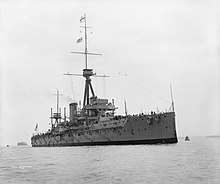
- 1914: First operational fighter aircraft, the Vickers F.B.5 (a.k.a. th "Gunbus"), developed from a design by Archibald Low (1888–1956).
- 1916: The tank developed and first used in combat by the British during World War I as a means to break the deadlock of trench warfare.[106] Key co-inventors include Major Walter Gordon Wilson (1874–1957) and Sir William Tritton (1875–1946).
- 1916: The first effective depth charge, an anti-submarine warfare weapon, developed from a design by Herbert Taylor at the RN Torpedo and Mine School, HMS Vernon.
- 1916: The Livens Projector, a weapon, created by William Howard Livens (1889–1964).[107]
- 1917: Dazzle camouflage created by Norman Wilkinson (1878–1971).
- 1917: ASDIC active sonar, the first practical underwater active sound-detection apparatus, developed by Canadian physicist Robert William Boyle and English physicist Albert Beaumont Wood (1890–1964).
- 1940s: High-explosive squash head, a type of ammunition, invented by Sir Charles Dennistoun Burney (1888–1968).
- 1941: The Fairbairn-Sykes fighting knife invented by William Ewart Fairbairn (1885–1960) and Eric A. Sykes (1883–1945).
- 1941–1942: The Bailey bridge – a type of portable, pre-fabricated, truss bridge – invented by Donald Bailey (1901–1985). Field Marshal Montgomery emphasised the importance of the Bailey bridge in Britain winning the war.[108][109]
- 1943: The bouncing bomb invented by Barnes Wallis (1887–1979).
- 1943: H2S radar (airborne radar to aid bomb targeting) invented by Alan Blumlein (1903–1942). Blumlein died in a plane crash during a secret trial of the H2S system.
- 1950: The steam catapult, a device used to launch aircraft from aircraft carriers, developed by Commander Colin C. Mitchell RNR.
- 1960s: Chobham armour, a type of vehicle armour, developed by a team headed by Gilbert Harvey[110] of the FVRDE at the tank research centre on Chobham Common, Surrey.
- 1960: Harrier Jump Jet developed by Hawker Aircraft of Kingston upon Thames following an approach by the Bristol Aeroplane Company in 1957.
- Late 1970s: Stun grenades developed by the British Army's SAS.[111]
Mining
- 1712: The Newcomen Engine invented by Thomas Newcomen (1664–1729); from c. 1705 Newcomen was first to use a Beam engine to pump water from mines.
- 1815: The Davy lamp, a safety lamp, invented by Humphry Davy (1778–1829).
- 1815: The Geordie lamp, a safety lamp, invented by George Stephenson (1781–1848).
Musical instruments
- 1695: Northumbrian smallpipes (a.k.a. Northumbrian pipes) associated with Northumberland and Tyne and Wear.
- 1711: The Tuning fork invented by John Shore (c. 1662–1752).
- 1798: The harp lute invented by Edward Light (c. 1747-c. 1832); Light patented the instrument in 1816.[112]
- Early 19th century: The Irish flute is not an instrument indigenous to Ireland; a key figure in its development was English inventor and flautist Charles Nicholson (1775–1810).
- 1829: The concertina invented by Charles Wheatstone (1802–1875).[32]
- Early 20th century: The theatre organ developed by Robert Hope-Jones (1859–1914).
- 1870: Carbon microphone, invented by David Edward Hughes.
- 1968: The logical bassoon, an electronically controlled version of the bassoon, developed by Giles Brindley (born 1926).[113]
Photography
.jpg)
- Before 1800: Method of copying images chemically to permanent media devised by Thomas Wedgwood (1771–1805).
- 1838: The Stereoscope, a device for displaying three-dimensional images, invented by Charles Wheatstone (1802–1875).[31][32]
- 1840: Calotype or Talbotype invented by William Fox Talbot (1800–1877).[114]
- 1850s: The Collodion process, an early photographic process, invented by Frederick Scott Archer (1813–1857).[115]
- 1850s: The Ambrotype invented by Frederick Scott Archer (1813–1857)[115] and Peter Wickens Fry (1795–1860).
- 1861: The Collodion-albumen process, an early dry plate process, invented by Joseph Sidebotham (father of Joseph Watson Sidebotham).
- 1871: The dry plate process, the first economically successful and durable photographic medium, invented by Richard Leach Maddox (1816–1902).
- 1878: The Horse in Motion or Sallie Gardner at a Gallop, a precursor to the development of motion pictures, created by Eadweard Muybridge (1830–1904).
- 1879: The Zoopraxiscope, which may be considered the first movie projector, created by Eadweard Muybridge (1830–1904).
- 1880s: Method of intensifying plates with mercuric iodide devised by B. J. Edwards (1838–1914); Edwards pioneered also the construction and design of instantaneous shutters.
- 1887: Celluloid motion pictures created by William Friese-Greene (1855–1921).
- 1906: Kinemacolor, the first successful colour motion picture process, invented by George Albert Smith (1864–1959).
Publishing firsts
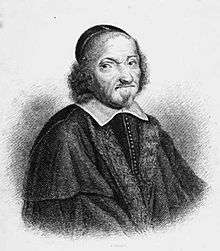
- 1475: First book printed in the English language, Recuyell of the Historyes of Troye, by William Caxton (c. 1422–c. 1491); eighteen copies survive.
- 1534: Cambridge University Press granted letters patent by Henry VIII; continuous operation since makes it the world's oldest publisher and printer.[116][117]
- 1535: First complete printed translation of the Bible into English produced by Myles Coverdale (1488–1569).[118]
- 1665: Philosophical Transactions, the first journal exclusively devoted to science, established by the Royal Society of London; it is also the world's longest-running scientific journal.[119]
- British Raj period: the first definite map of India drawn by English cartographers.
- Mid-19th century: First noted journal club by English surgeon Sir James Paget (1814–1899); recalling in his memoirs time spent at St. Bartholomew's Hospital in London, Paget describes "a kind of club [. . .] a small room over a baker's shop near the Hospital-gate where we could sit and read the journals."[120]
- 1893: Benjamin Daydon Jackson prepares the first volume of Index Kewensis, first publication aiming to register all botanical names for seed plants at the rank of species and genera.
Science
Physics

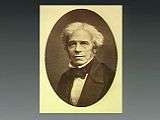
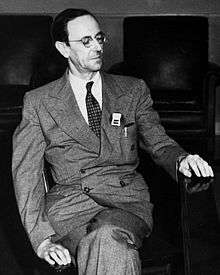
- 1600: Recognition that the earth was a giant magnet, by William Gilbert (1544–1603) in his six-book work De Magnete; De Magnete was known all over Europe, and was almost certainly an influence on Galileo.
- 1660: Hooke's Law (equation describing elasticity) proposed by Robert Hooke (1635–1703).[18]
- 1666–1675: Theories on optics proposed by Sir Isaac Newton (1642–1726/7); Newton published Opticks in 1704.
- 1687: Law of universal gravitation formulated in the Principia by Sir Isaac Newton (1642–1726/7).
- 1687: Newton's laws of motion formulated in the Principia.
- 1800: Infrared radiation discovered by Sir William Herschel (1738–1822).
- 1802: Theory on physiological basis of colour vision proposed by Thomas Young (1773–1829).
- 1803–1807: Evidence for a wave theory of light discovered by Thomas Young (1773–1829).
- 1823: Electromagnet invented by William Sturgeon (1783–1850).[121]
- 1831: Discovery that electric current could be generated by altering magnetic fields (the principle underlying modern power generation) by Michael Faraday (1791–1867).[58]
- 1845: Proposition that light and electromagnetism are related by Michael Faraday (1791–1867).[58]
- 1845–1847: Demonstration that electric circuits obey the law of the conservation of energy and that electricity is a form of energy (First Law of Thermodynamics) by James Joule (1818–1889); the unit of energy the Joule is named after him.
- 1871 and 1885: Discovery of the phenomenon Rayleigh scattering (which can be used to explain why the sky is blue), and prediction of the existence of surface waves by John Strutt, 3rd Baron Rayleigh (1842–1919).[122]
- 1897: Discovery of the electron by J. J. Thomson (1856–1940).
- 1911: Discovery of the Rutherford model of the Atom by Ernest Rutherford (1871–1937).
- 1912: Invention of the mass spectrometer by J. J. Thomson (1856–1940).
- 1912: Bragg's law and the field of X-ray crystallography, an important tool for elucidating the crystal structure of substances, discovered by William Henry Bragg (1862–1942) and William Lawrence Bragg (1890–1971).[123]
- 1913: Discovery of isotopes by J. J. Thomson (1856–1940).
- 1917: Discovery of the Proton by Ernest Rutherford (1871–1937).
- 1924: Edward Victor Appleton awarded Nobel Prize in Physics in 1947 for proving the existence of the ionosphere during experiments carried out in 1924.
- 1928: Existence of antimatter predicted by Paul Dirac (1902–1984); Dirac made major contributions to the development of quantum mechanics.
- 1932: Splitting the atom, a fully artificial nuclear reaction and nuclear transmutation, first achieved by English physicist John Cockcroft (1897–1967) and Ireland's Ernest Walton.
- 1932: Discovery of the Neutron by James Chadwick (1891–1974).
- 1935: Possibility of Radar first proven in the "Daventry experiment" by Englishman Arnold Frederic Wilkins (1907–1985) and Scot Robert Watson-Watt.
- 1947: Holography invented in Rugby, England by Hungarian-British Dennis Gabor (1900–1979; fled from Nazi Germany in 1933). The medium was improved by Nicholas J. Phillips (1933–2009), who made it possible to record multi-colour reflection holograms.
- 1947: Discovery of the pion (pi-meson) by Cecil Frank Powell (1903–1969).
- 1964: The Higgs boson, an elementary particle implied by the Higgs field, proposed by Peter Higgs (born 1929) and others to explain why fundamental particles (which are theoretically weightless) might have acquired mass after their formation in the Big Bang.
- 1974: Hawking radiation predicted by Stephen Hawking (1942–2018).
Chemistry
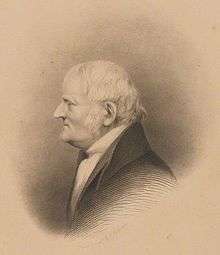
- Anglo-Saxon times: Anglo-Saxon goldsmiths used a process similar to cementation; as evidenced by the Staffordshire hoard.[124]
- 1665: Correct theory of combustion first outlined in Micrographia by Robert Hooke (1635–1703); Hooke observed that something (known now as oxygen) is taken from the air and that in its absence combustion quickly ceases, however much heat is applied.
- 1766: Hydrogen discovered by Henry Cavendish (1731–1810); Cavendish described it as a colourless, odourless gas that burns and can form an explosive mixture with air.[125]
- 1775: Oxygen discovered by Joseph Priestley (1733–1804); Priestley called it "dephlogisticated air".[126]
- 1791: William Gregor (25 December 1761 – 11 June 1817) discovered the elemental metal titanium.[127]
- 1801: Charles Hatchett FRS (2 January 1765 – 10 March 1847[1]) discovered the element niobium.[128]
- 1803: William Hyde Wollaston PRS (6 August 1766 – 22 December 1828) discovered the chemical element rhodium.[129]
- 1803: William Hyde Wollaston PRS (6 August 1766 – 22 December 1828) discovered the chemical element palladium.[130]
- 1803: Smithson Tennant FRS (30 November 1761 – 22 February 1815) discovered the element iridium.[131]
- 1803: Smithson Tennant FRS (30 November 1761 – 22 February 1815) discovered the element osmium.[132]
- 1803: Modern atomic theory developed by John Dalton (1766–1844).[55][121] See also Dalton's law and Law of multiple proportions; Dalton is considered the father of modern chemistry.[133]
- 1807: Sodium isolated by Sir Humphry Davy (1778–1829).[134]
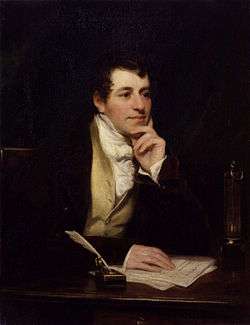
- 1807: Potassium isolated by Sir Humphry Davy (1778–1829).[55]
- 1808: Calcium isolated by Sir Humphry Davy (1778–1829).[135]
- 1808: Strontium isolated by Sir Humphry Davy (1778–1829).[135]
- 1808: Barium isolated by Sir Humphry Davy (1778–1829).[135]
- 1808: Magnesium isolated by Sir Humphry Davy (1778–1829).[135]
- 1808: Boron isolated by Sir Humphry Davy (1778–1829).[55][135]
- 1810: Elemental nature of Chlorine discovered by Sir Humphry Davy (1778–1829).
- 1813: Elemental nature of Iodine discovered by Sir Humphry Davy (1778–1829).
- 1825: Benzene, the first known aromatic hydrocarbon, isolated and identified by Michael Faraday (1791–1867).[136]
- 1861: Thallium discovered by William Crookes (1832–1919).[55]
- 1865: Periodic Table devised by John Newlands (1837–1898); his Law of Octaves was a precursor to the Periodic Law.[137]
- 1868: Helium discovered in the sun (via spectroscopy) by Norman Lockyer (1836–1920); not until ten years later was it found on earth.
- 1868: Synthesis of coumarin (one of the first synthetic perfumes), and cinnamic acid via the Perkin reaction by William Henry Perkin (1838–1907).
- 1893: The Weston cell developed by England-born chemist Edward Weston (1850–1936).[138]
- 1894: Argon discovered by English physicist John Strutt, 3rd Baron Rayleigh (1842–1919) and Scot William Ramsay.
- 1898: Morris Travers was an English chemist who with scot Sir William Ramsay discovered xenon, neon and krypton.[139]
- 1901: Silicone discovered and named by Frederic Kipping (1863–1949); according to the nomenclature of modern chemistry, silicone is no longer the correct term, but it remains in common usage.
- 1913: Concept of atomic number introduced by Henry Moseley (1887–1915) in order to fix the inadequacies of Mendeleev's periodic table, which had been based on atomic weight.[140] Isaac Asimov wrote, "In view of what he [Moseley] might still have accomplished … his death might well have been the most costly single death of the War to mankind generally."[141]
- 1913: Existence of isotopes first proposed by Frederick Soddy (1877–1956).[55]
- 1940s / 1950s: Partition chromatography developed by Richard Laurence Millington Synge (1914–1994) and Archer J.P. Martin (1910–2002).[142]
- 1950: VX (nerve agent) invented by Ranajit Ghosh at Porton Down, VX (nerve agent) is the worlds most deadly chemical compounds. It only takes 10 milligrams to become a fatal dose.
- 1952: Structure of ferrocene discovered by Geoffrey Wilkinson (1921–1996) and others.[143]
- 1959: First practical hydrogen–oxygen fuel cell developed by Francis Thomas Bacon (1904–1992).[144]
- 1962: First noble gas compound, xenon hexafluoroplatinate, prepared by Neil Bartlett (1932–2008).
- 1985: Buckminsterfullerene discovered by Sir Harry Kroto (born 1939).[145]
Biology

- 1665: Cell biology originated by Robert Hooke (1635–1703), who discovered the first cells in the course of describing the microscopic compartments within cork.[121]
- Early 19th century: the first recognition of what fossils were by Mary Anning.
- 1839: The identification and discovery of 150 mosses, lichens, liverworts, flowering plants and algae on the Kerguelen Islands by botanist Joseph Dalton Hooker. He later said of his gatherings "many of my best little lichens were gathered by hammering out the turfs or sitting on them till they thawed."
- 1855: The discovery of the first coal ball by Joseph Dalton Hooker who later on with partner William Binney made the first scientific description of coal balls.
- 1859: Theories of evolution by natural selection and sexual selection set out in On the Origin of Species by Charles Darwin (1809–1882).
- 1883: The practice of Eugenics developed by Sir Francis Galton (1822–1911), applying his half-cousin Charles Darwin's theory of evolution to humans.[146]
- 1953: Double-helix structure of DNA determined by Englishman Francis Crick (1906–2004)[147] and American James Watson. Crick was a pioneer in the field of molecular biology.
- 1958: the first cloning of an animal, a frog using intact nuclei from the somatic cells of a Xenopus tadpole by Sir John Gurdon.
- 1950 onward: the pioneering of the use of Xenopus eggs to translate microinjected messenger RNA molecules by Sir John Gurdon and fellow researchers, a technique which has been widely used to identify the proteins encoded and to study their function.
- 1960 onwards: Pioneering observation-based research into the behaviour of chimpanzees (our closest relatives in the animal kingdom) conducted by Jane Goodall (born 1934).
- 1977: DNA sequencing by chain termination developed by Frederick Sanger (1918–2013).[148] Sanger won the Nobel Prize for Chemistry twice.
- 1977: Discovery of introns in eukaryotic DNA and the mechanism of gene-splicing by Richard J. Roberts (born 1943).[149]
- 1996: Dolly the Sheep born as a result of Nuclear transfer, a form of cloning put into practice by Ian Wilmut (born 1944) and Keith Campbell (1954–2012).
- 2016: Scientists at the British bio-tech company Oxitec, in an attempt to stop the spread of dengue fever genetically engineer a 'sudden death' mosquito which after mating successfully with a wild female, any offspring produced will not survive to adulthood and the lethal gene is passed on from the female to any male they mate with and the cycle continues. 3,019,000 mosquitos were released on the Grand Cayman Islands and after three months 80% of the population of mosquitos in the target area had vanished.
Mathematics and statistics
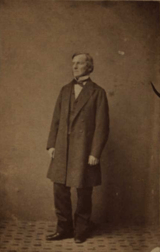
- 1630–1632: The slide rule invented by William Oughtred (1574–1660), developing on work by Edmund Gunter (1581–1626) and Edmund Wingate (1596–1656).[18][150]
- 1631: The "x" symbol for multiplication and the abbreviations "sin" and "cos" for the sine and cosine functions devised by William Oughtred (1574–1660) in Clavis Mathematicae (The Key to Mathematics).
- 1631: The symbols for "is less than" and "is greater than", along with other innovations, devised in the posthumously published algebra text Artis Analyticae Praxis by Thomas Harriot (c. 1560–1621).
- 1687: Calculus developed by Sir Isaac Newton (1642–1726/7), as set out in his Principia Mathematica.
- 1763 onwards: Key contributions made to the development of statistics by: Thomas Bayes (c. 1701–1761) (Bayes' theorem); Florence Nightingale (1820–1910) (statistical graphics); Francis Galton (1822–1911) (standard deviation, correlation, regression, questionnaires); Karl Pearson (1857–1936) (correlation coefficient, chi-square); William Gosset (1876–1937) (Student's t-distribution); Ronald Fisher (1890–1962) (Analysis of variance); Frank Yates (1902–1994).
- 1854: Boolean algebra, the basis for digital logic, proposed by George Boole (1815–1864).
- 1876: Connection between energy, matter and the curvature of space proposed in s:On the Space-Theory of Matter by William Kingdon Clifford (1845–1879), forty years before Einstein's general theory of relativity.
- c. 1880: The Venn diagram devised by John Venn (1834–1923).
- 1884: Reformulation of Maxwell's equations into the four we know now by Oliver Heaviside (1850–1925).
- 1901: Discipline of modern mathematical statistics developed by Karl Pearson (1857–1936).[151][152]
Astronomy
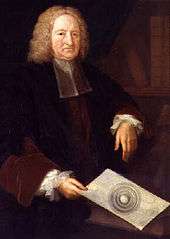
- 1609: First drawing of the Moon through a telescope by Thomas Harriot (c. 1560 – 1621); Harriot achieved this on 26 July 1609: over four months before Galileo.[153][154]
- 1610: Sunspots discovered by Thomas Harriot (c. 1560–1621).[155]
- 1668: Newtonian telescope invented by Sir Isaac Newton (1642–1727).[156]
- 1705: Periodicity of Halley's Comet determined by Edmond Halley (1656–1742).[157]
- 1712–1717: The Planetarium created by French-born Briton John Theophilus Desaguliers (1683–1784).[158]
- 1758: Achromatic doublet lens patented by John Dollond (1706–1761).[159]
- 1781: Discovery of the planet Uranus by Sir William Herschel (1738–1822);[160] Herschel also discovered the moons Titania (1787), Oberon (1787), Enceladus (1789), and Mimas (1789).[161]
- 1783: Existence of black holes first proposed by John Michell (1724–1793); Michell was first to suggest that double stars might be attracted to each other (1767), and he invented the torsion balance (before 1783).[162]
- 1843: Existence and position of Neptune predicted, using only mathematics, by John Couch Adams (1819–1892).[163]
- 1845: Nature of spiral galaxies discovered by William Parsons, 3rd Earl of Rosse (1800–1867).[164]
- 1846: Discovery of Triton by William Lassell (1799–1880);[165] Lassell also discovered the moons Hyperion (1848), Ariel (1851), and Umbriel (1851).[166]
- 1924: The Eddington limit – the natural limit to the luminosity of stars, or the radiation generated by accretion onto a compact object – discovered by Sir Arthur Stanley Eddington (1882–1944).[167]
- 1930s–1950s: Important contributions to the development of radio astronomy made by Bernard Lovell (1913–2012).[168]
- 1946–1954: Pioneering theories of Nucleosynthesis (the formation of chemical elements in stars and supernova) proposed by Sir Fred Hoyle (1915–2001); in 1949, Hoyle coined the term "Big Bang".[169]
- 1966 onwards: Important contributions to cosmology and (from 1973)quantum gravity made by Stephen Hawking (born 1942), especially in the context of black holes.
- 1967: Pulsars discovered by English radio astronomer Antony Hewish (born 1924) and one of his graduate students, Northern Irish Jocelyn Bell.[170]
- Late 1960s / early 1970s: Aperture synthesis, used for accurate location and imaging of weak radio sources in the field of radio astronomy, developed by Martin Ryle (1918–1984) and Antony Hewish (born 1924).[171]
Geology and meteorology
- 1802: Nomenclature system for clouds developed by meteorology pioneer Luke Howard (1772–1864).[172]
- 1815: First geological map of Great Britain created by William Smith (1769–1839); Smith is responsible, as well, for the observation that fossils can be used to work out the relative ages of rocks and strata (Principle of Faunal Succession).
- 1820: The dew-point hygrometer, an instrument used for measuring the moisture content in the atmosphere, invented by John Frederic Daniell (1790–1845).
- 1820s: Scientific study of dinosaurs initiated by Gideon Mantell (1790–1852).
- 1861: First weather map created by Francis Galton (1822–1911).[173]
- 1880: The Seismograph, for detecting and measuring the strength of earthquakes, invented by John Milne (1850–1913).
- 1911 onwards: Geochronology pioneered by Arthur Holmes (1890–1965).[174]
- 1938–1964: The Callendar effect, a theory linking rising carbon dioxide concentrations in the atmosphere to global temperature (Global warming), proposed by Guy Stewart Callendar (1898–1964).
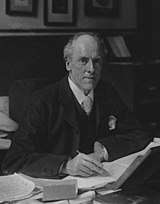
Philosophy of science
- c. 1240s: An early framework for the scientific method, based in Aristotelian commentaries, proposed by English statesman, scientist and Christian theologian Robert Grosseteste (c. 1175–1253).[175]
- 1267: Early form of the scientific method articulated in Opus Majus by Roger Bacon (c. 1214?-c. 1292?).[176]
- 1620: Baconian method, a forerunner of the scientific method, proposed in the Novum Organum by Sir Francis Bacon (1561–1626).[177]
- 1892: Scope and method of science proposed in The Grammar of Science by Karl Pearson (1857–1936); the book was a pivotal influence on the young Albert Einstein and contained several ideas that were later to become part of his theories.[178]
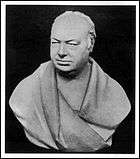
Scientific instruments
- 1630–1632: The slide rule invented by William Oughtred (1574–1660), developing on work by Edmund Gunter (1581–1626) and Edmund Wingate (1596–1656).[18][150]
- 1630s: The micrometer invented by William Gascoigne (1612–1644).
- 1665: Compound microscope with 30x magnification developed by Robert Hooke (1635–1703); Hooke published Micrographia in 1665.
- 1668: The marine barometer invented by Robert Hooke (1635–1703).[18]
- 1677: The Coggeshall slide rule, a.k.a. the carpenter's slide rule, invented by Henry Coggeshall (1623–1691).[179]
- 1763: Triple achromatic lens invented by Peter Dollond (1731–1820).
- 1784: The Atwood machine, for demonstrating the law of uniformly accelerated motion, invented by George Atwood (1745–1807).
- c. 1805: First bench micrometer – the "Lord Chancellor", capable of measuring to one ten-thousandth of an inch – invented by Henry Maudslay (1771–1831), a founding father of machine tool technology.[180]
- 1833: Wheatstone bridge invented by Samuel Hunter Christie (1784–1865); improved and popularised in 1843 by Charles Wheatstone (1802–1875).
- 1972: The Sinclair Executive, the world's first small electronic pocket calculator, invented by Sir Clive Sinclair (born 1940).
Sport

- Before 1299: Bowls or lawn bowls can be traced to 13th-century England.[181] The world's oldest surviving bowling green is Southampton Old Bowling Green, first used in 1299.
- Late 15th century: Rounders developed from an older English game known as stoolball.[182]
- Early 16th century: Modern boxing developed from bare-knuckle boxing or prizefighting, a resurfacing of Ancient Greek boxing in England. The first recorded boxing match took place on 6 January 1681 in England, arranged by Christopher Monck, 2nd Duke of Albemarle (1653–1688).
- 1519: World's oldest sporting competition still running, the Kiplingcotes Derby horse-race, established; it has run annually since without a break.[183][184]
- 1530s: Origin of real tennis played with rackets, popularised by Henry VIII.[185]
- 1598: The earliest definite reference to cricket; the sport may arguably be traced further back to 1301 with written evidence of a game known as creag played by Prince Edward, son of Edward I (Longshanks).[186]
- Aunt Sally, early 17th century.
- After 1660: Thoroughbred horseracing developed in 17th- and 18th-century England; royal support from Charles II, a keen racegoer and owner, made horse-racing popular with the public.
- 1673: Oldest non-equine competition in England, the Scorton Arrow archery tournament, established in Scorton, Yorkshire.[187]
- 1715: Oldest rowing race in the world, Doggett's Coat and Badge established; the race on the River Thames) has been held every year since 1715.
- 1744: Earliest description of baseball in A Little Pretty Pocket-Book by John Newbery (1713–1767); the first recorded game of "Bass-Ball" took place in 1749 in Surrey.[188] William Bray (1736–1832) recorded a game of baseball on Easter Monday, 1755 in Guildford, Surrey; the game is considered to have been taken across the Atlantic by English emigrants.[189]
- Early 19th century: Modern field hockey developed in English public schools; the first club was established in 1849 in Blackheath, London.
- 1820s: Ice hockey, a variant of field hockey, invented by British soldiers based in Canada. British soldiers and emigrants to Canada and the United States played their stick-and-ball games on the winter ice and snow; in 1825, John Franklin (1786–1847) wrote during one of his Arctic expeditions: "The game of hockey played on the ice was the morning sport" on Great Bear Lake.[190]
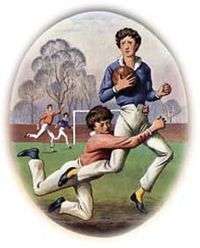
- 1823 or 1824: Invention of Rugby football credited to William Webb Ellis (1806–1872).
- 1850: The format of the modern Olympic Games inspired by William Penny Brookes (1809–1895); see also the Cotswold Olimpick Games.
- c. 1850: A bowling machine for cricket named the Catapulta (a predecessor of the pitching machine) invented by Nicholas "Felix" Wanostrocht (1804–1876).[191]
- 1857: Sheffield F.C. formed by former public school pupils, making it the world's first and oldest Association football club, as acknowledged by The Football Association and FIFA.[192]
- 1867: Coconut shy in Kingston, Surrey.
- 1859–1865: Lawn tennis invented by Harry Gem (1819–1881) and Augurio Perera, a Spanish-born merchant and sportsman based in England.
- 1874–1875: Snooker invented by the British Army in India.[193]
- 1874: Formal codification of the rules of modern Polo established by the Hurlingham Polo Association; polo had been introduced to England in 1834 by the 10th Hussars at Aldershot, Hants, and in 1862 the first polo club, Calcutta Polo Club, was established by two British soldiers, Captain Robert Stewart and (later Major General) Joe Sherer.[194]
- 1880 onwards: Modern rock climbing developed by Walter Parry Haskett Smith (1859–1946), so-called "father of rock climbing".
- 1880s: Table tennis or ping-pong originated in Victorian England as an indoor version of tennis; it was developed and played by the upper class as an after-dinner parlour game.[195][196]
- 1888: Tiddlywinks patent application by London bank clerk[197] Joseph Assheton Fincher (1863–1900);[198][199] tiddlywinks originated as an adult parlour game in Victorian England.[200]
- 1893–1897: Netball developed from early versions of women's basketball at Madame Österberg's College in England.[201]
- 1895: Rugby league created with the establishment of the Northern Rugby Football Union (NRFU) as a breakaway faction of England's Rugby Football Union (RFU).
- 1896: The dartboard-layout used in the game and professional competitive sport of Darts was devised by Lancashire carpenter Brian Gamlin (c. 1852–1903); Gamlin died before he could patent his idea.[202]
- 1899: Mixed martial art (MMA) Bartitsu invented by Edward William Barton-Wright (1860–1951).
- 1948: The first Paralympic games competition, originally the Stoke Mandeville Games, created in England by German-born (from 1945 naturalised) British neurologist Ludwig Guttmann (1899–1980).[203]
- 1954: Sir Roger Bannister (1929–2018) ran the first sub-four-minute mile on 6 May 1954.
- 1979: First modern bungee jumps made from the 250-foot (76 m) Clifton Suspension Bridge in Bristol by members of the Oxford University Dangerous Sports Club.[204]
Transport
Aviation

- 1799: Concept of the modern aeroplane as a fixed-wing flying machine with separate systems for lift, propulsion, and control set forth by Sir George Cayley (1773–1857);[205][206] Cayley is one of the most important people in the history of Aeronautics and flight: he is sometimes called the "father of aviation".[207]
- 1804: First glider to carry a human being aloft designed by Sir George Cayley (1773–1857). Cayley discovered and identified the four aerodynamic forces of flight: weight, lift, drag, and thrust; Modern aeroplane design is based on those discoveries, along with cambered wings which Cayley also discovered.[207]
- 1837: Pioneering contribution to parachute design made by Robert Cocking (1776–1837); aged 61, Cocking was the first person to be killed in a parachuting accident.
- 1844: Hale rockets, an improved version of the Congreve rocket design that introduced thrust vectoring, invented by William Hale (1797–1870).
- 1848: World's first powered flight (of 30 feet) achieved in Chard, Somerset with the Aerial Steam Carriage by John Stringfellow (1799–1883),[208] 55 years before the Wright brothers;[209] Stringfellow and William Samuel Henson (1812–1888) patented their invention in 1842.[210]
- Late-19th century: The term "air port" first used – to describe the port city Southampton, where some early flying boats landed.[211]

- 1929: Turbojet engine single-handedly invented by Sir Frank Whittle (1907–1996).[212]
- 1949: First commercial jet airliner, the de Havilland Comet,[213] designed, developed and manufactured by de Havilland.
- 1954: First aircraft capable of supercruise, the English Electric Lightning, designed, developed and manufactured by English Electric.
- 1959: Aerospace engineer John Hodge (born 1929) migrated to become part of NASA's Space Task Group, which was responsible for America's manned space programme, Project Mercury.
- 1960: VTOL (Vertical Take-Off and Landing) aircraft (most famously the Harrier) invented by Gordon Lewis (1924–2010), Ralph Hooper (born 1926), Stanley Hooker (1907–1984) and Sydney Camm (1893–1966);[214] the project developed on ideas by Frenchman Michel Wibault.
- 1965: Concorde The world's first supersonic commercial aircraft (A joint development between British Airways, Air France) invented by Sir James Hamilton (1923–2012); the project was manufactured by BAC, Sud Aviation. It took Concorde three hours, fifteen minutes to fly from London Heathrow to New York JFK.
Railways
- 1825: Opening of the Stockton and Darlington Railway, the world's first operational steam passenger railway; it was taken over by the North Eastern Railway in 1863.
- 1830: Opening of the Liverpool and Manchester Railway, the first inter-city steam-powered railway; the railway was absorbed by the Grand Junction Railway in 1845.
- 1838: Opening of the first stretch of the Great Western Railway, from London Paddington station to (the original) Maidenhead station, engineered by Isambard Kingdom Brunel (1806–1859).
Locomotives
- 1802: First full-scale railway steam locomotive built by Richard Trevithick (1771–1833).[215] This built on the endeavours of two other Englishmen, engineer Thomas Savery (c.1650–1715), son of Devon, and the first practical steam engine built in 1712 by Londoner Thomas Newcomen (c.1664–1729). James Watt did not invent the steam engine. Rather Watt, prompted by English backer and manufacturer Matthew Boulton, effected improvements sufficient to make the invention commercial viable.
- 1812: First commercially viable steam locomotive, the twin cylinder Salamanca, designed and built by Matthew Murray (1765–1826) of Holbeck.
- 1813: First practical steam locomotive to rely simply on the adhesion of iron wheels on iron rails, Puffing Billy, built by William Hedley (1779–1843).
- 1814: First successful flanged-wheel adhesion locomotive, the Blücher, built by George Stephenson (1781–1848).
- 1824: First steam locomotive to carry passengers on a public rail-line, the Locomotion No. 1, built by Robert Stephenson (1803–1859), son of George Stephenson.
- 1829: Stephenson's Rocket built by George Stephenson (1781–1848) and his son Robert Stephenson (1803–1859); the Rocket was not the first steam locomotive, but it was the first to bring together several innovations to produce the most advanced locomotive of its day.
- 1829: The Sans Pareil, a less advanced competitor of Stephenson's Rocket, built by Timothy Hackworth (1786–1850).
- 1829: The Stourbridge Lion, first steam locomotive to be operated in the United States, built by Foster, Rastrick and Company of Stourbridge, Worcestershire, now West Midlands; the manufacturing company was headed by James Foster (1786–1853) and John Urpeth Rastrick (1780–1856).
- 1835: Der Adler the first steam locomotive in Germany. Built by George & Robert Stephenson in Newcastle.
- 1923: The Flying Scotsman built to a design by Sir Nigel Gresley (1876–1941);[216] the Flying Scotsman was in 1934 the first steam locomotive to be authenticated at reaching 100 miles per hour (160.9 km/h) in passenger service.[217]
Other railway developments

- 1842: The Edmondson railway ticket invented by Thomas Edmondson (1792–1851); British Rail used Edmondson tickets until February 1990.[218]
- 1852 onwards: Numerous inventions for railways by John Ramsbottom (1814–1897), including: the split piston ring (1852), the Ramsbottom safety valve (1855), the Displacement lubricator (1860), and the water trough (1860).
- 1863: Opening of the world's oldest underground railway, the London Underground, a.k.a. the Tube; the Tube is the oldest rapid transit system, and it was the first underground railway to operate electric trains.
- Late 1940s: Maglev, the use of magnetic levitation to move vehicles without touching the ground, invented by Eric Laithwaite (1921–1997).
- 1981: The Advanced Passenger Train (APT), an experimental high-speed train that pioneered tilting, introduced by British Rail.
Roads
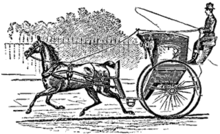
- 1804: The seat belt invented by Sir George Cayley (1773–1857).[219]
- 1808: Tension-spoke wire wheels invented by Sir George Cayley (1773–1857).[207]
- 1829: First practical steam fire engine invented by John Braithwaite the younger (1797–1880).
- 1834: The Hansom cab, a type of horse-drawn carriage, invented by Joseph Hansom (1803–1882).
- 1868: First traffic lights (manually operated and gas-lit) installed outside London's Houses of Parliament; invented by John Peake Knight (1828–1886).
- c. 1870: "Ariel", a penny-farthing bicycle, developed by James Starley (1831–1881).
- 1876: The legal collection of 70,000 thousands seeds from the rubber bearing tree hevea brasiliensis which led to the discovery of the perfect growing climate and locations for rubber trees by Sir Henry Alexander Wickham. Most commercial rubber plants are descended from the seeds he took to Kew Gardens
- 1884:Thomas Parker claimed to have invented the first electric car.[220]
- 1885: First commercially successful safety bicycle, "the Rover", developed by John Kemp Starley (1855–1901).
- 1901: Tarmac patented by Edgar Purnell Hooley (1860–1942).
- c. 1902: The invention of the Bowden cable popularly attributed to Sir Frank Bowden (1848–1921), founder and owner of the Raleigh Bicycle Company.
- 1910: Opening of the oldest existing driving school and first formal driving tuition provider, the British School of Motoring, in Peckham, London.[221]
- 1922: Horstmann suspension, a coil spring suspension system commonly used on western tanks, invented by Sidney Horstmann (1881–1962).
- 1926: First automated traffic lights in England deployed in Piccadilly Circus in 1926;[222] outside of London, Wolverhampton was in 1927 the first British town to introduce automated traffic lights.[223]
- 1934: The Cat's eye, a safety device used in road marking, invented by Percy Shaw (1890–1976).[224]
- 1934: The Belisha beacon introduced by Leslie Hore-Belisha (1893–1957).
- 1962: First modern Formula One car, the Lotus 25, designed by Colin Chapman (1928–1982) for Team Lotus; the design incorporated the first fully stressed monocoque chassis to appear in automobile racing.
- 1985: The Sinclair C5, a one-person battery electric vehicle, invented by Sir Clive Sinclair (born 1940).
- 1997: World Land Speed Record, 1,228 km/h (763 mph), achieved by ThrustSSC, a jet-propelled car designed and built in England. Project director: Richard Noble (born 1946); designed by Ron Ayers (born 1932), Glynne Bowsher and Jeremy Bliss; piloted by Andy Green (born 1962).
Sea
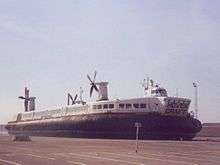
- 1578: The first submersible (a small, submarine-like vehicle) of whose construction there exists reliable information designed by Englishman William Bourne (c. 1535–1582) in his book Inventions or Devises; Dutchman Cornelius Drebbel put Bourne's concept into action in 1620.
- 1691: A diving bell capable of allowing its occupier to remain submerged for extended periods of time, and fitted with a window for the purpose of underwater exploration, designed by Edmund Halley (1656–1742),[225] best known for computing the orbit of Halley's Comet.
- c. 1730: The octant invented by English mathematician John Hadley (1682–1744); American optician Thomas Godfrey developed the instrument independently at approximately the same time.
- 1743: The "Whirling Speculum", a device used to locate the horizon in foggy or misty conditions, invented by John Serson (died 1744); Serson's Speculum can be seen as a precursor to the gyroscope.
- 1757: First sextant made by John Bird (1709–1776),[226] adapting the principle of Hadley's octant.
- 1785: The lifeboat invented and patented by Lionel Lukin (1742–1834); William Wouldhave (1751–1821) made a rival claim, but he did not succeed with the practical application of his invention until 1789.
- 1799: The Transit, a type of sailing vessel with a remarkable turn of speed, patented by Richard Hall Gower (1768–1833).
- 1835: The screw propeller invented and patented by Francis Pettit Smith (1808–1874).
- 1843: Launch of the SS Great Britain – the first steam-powered, screw propeller-driven passenger liner with an iron hull; designed by Isambard Kingdom Brunel (1806–1859), it was at the time the largest ship afloat.
- 1876: Plimsoll Line devised by Samuel Plimsoll (1824–1898).
- 1878: First commercially successful closed-circuit scuba designed and built by Henry Fleuss (1851–1932), a pioneer in the field of diving equipment.
- 1878–1879: Two early Victorian submarines, Resurgam I and Resurgam II, designed and built by George Garrett (1852–1902).
- 1894: The first steam turbine powered steamship, Turbinia (easily the fastest ship in the world at the time), designed by Anglo-Irish engineer Sir Charles Algernon Parsons (1854–1931), and built in Newcastle upon Tyne.
- 1899–1901: Developments on the hydrofoil by shipbuilder John Isaac Thornycroft (1843–1928), from the concept of Italian Enrico Forlanini.
- 1912: World's first patent for an underwater echo ranging device (sonar) filed a month after the sinking of the Titanic by Lewis Richardson (1881–1953).
- 1915: Research into solving the practical problems of submarine-detection by sonar led by Ernest Rutherford (1871–1937).[227]
- 1955: The hovercraft invented by Sir Christopher Cockerell (1910–1999).
Miscellaneous
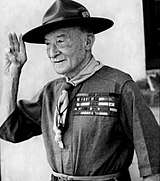
- 1286: First recorded use of the Halifax Gibbet, an early guillotine.
- Early 17th century: The closely cut "English" lawn created in the Jacobean epoch of gardening, as the garden and the lawn became places created first as walkways and social areas. The English lawn became a symbol of status of the aristocracy and gentry; it showed that the owner could afford to keep land that was not being used for a building or for food production.
- 1668: Earliest concept of a metric system proposed by John Wilkins (1614–1672) in An Essay towards a Real Character and a Philosophical Language.
- 1706: World's first life insurance company, the Amicable Society, founded by William Talbot (1658–1730) and Sir Thomas Allen, 2nd Baronet (c. 1648–1730).
- 1719: Oldest music-based festival, the Three Choirs Festival, established.
- 1725: The modern kilt, associated since the 19th century with Scottish culture, arguably invented by English Quaker Thomas Rawlinson (dates not known).[228][229][230]
- c. 1760: The jigsaw puzzle invented and commercialised by cartographer John Spilsbury (1739–1769).[231]
- 1767: The carbonated soft drink invented by Joseph Priestley (1733–1804).
- 1768–1770: The modern circus invented by Philip Astley (1742–1814) in Astley's Amphitheatre on Westminster Bridge Road in Lambeth.[232][233]
- c. 1770: The lorgnette (a pair of spectacles with a handle, used to hold them in place, rather than fitting over the ears or nose) invented by George Adams I (c. 1709–1773) and subsequently illustrated in his son George Adams II's An Essay on Vision, briefly explaining the fabric of the eye (1789).[234]
- 1772: Oldest arts festival established in Norwich 1772.[235]
- 1787: First glee club founded in Harrow School.[236]
- 1797: The top hat arguably invented by English haberdasher John Hetherington (dates not known).
- 1798: Consequences of population growth identified by Thomas Robert Malthus (1766–1834) in An Essay on the Principle of Population.
- 1798: Oldest police force in continuous operation, the Marine Police Force, formed by English seafarer John Harriott (1745–1817) and Scot Patrick Colquhoun; it merged with the nascentMetropolitan Police Service in 1839.
- 18th century – 19th century: The history of comics developed with innovations by William Hogarth (1697–1764), James Gillray (1756/57–1815), George Cruikshank (1792–1878) and others. The Glasgow Looking Glass (1826), arguably the first comic strip. William Heath was its principal strip illustrator.[237][238]
- 1811: The graphic telescope, a drawing aid with the power of a telescope, invented by water-colour painter Cornelius Varley (1781–1873).
- 1821: World's first modern nature reserve established by naturalist and explorer Charles Waterton (1782–1965); Waterton was described by David Attenborough as "one of the first people anywhere to recognise not only that the natural world was of great importance but that it needed protection as humanity made more and more demands on it".[239]
- 1824: Rubber balloon invented by Michael Faraday (1791–1867) during experiments with gases.
- 1824: First animal welfare society, the RSPCA, founded by a group of reformers including William Wilberforce.
- 1826: First effective friction match invented by John Walker (1781–1859).
- 1829: Metropolitan Police Force founded by Home Secretary Sir Robert Peel; by 1857 all cities in the UK were obliged to form their own police forces.
- 1837 Egg-free custard by Alfred Bird
- 1840: Stamp collecting initiated by zoologist John Edward Gray (1800–1875); on 1 May 1840, the day the Penny Black first went on sale, Gray bought several with the intent to save them.[240]
- 1844: The Rochdale Society of Equitable Pioneers founded in Lancashire. The Rochdale Principles are the foundation for the co-operative principles on which co-ops around the world operate to this day.
- 1844: YMCA (Young Men's Christian Association) founded in London by Sir George Williams (1821–1905), with the aim of putting Christian values into practice.
- 1846: The Christmas cracker invented by London confectioner Thomas J. Smith by wrapping a bon-bon in a twist of coloured paper, adding a love note, a paper hat and a banger mechanism. This new idea took of and the bon-bon was eventually replaced by a small toy or novelty.
- 1849: Bowler hat designed by London hat-makers Thomas and William Bowler.
- 1851: Prime meridian established at Greenwich by Sir George Biddell Airy (1801–1892), Astronomer Royal from 1835 to 1881); Airy's line, the fourth Greenwich Meridian, became the definitive, internationally recognised line in 1884.
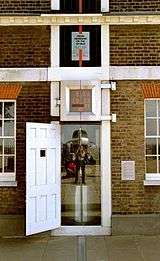
- 1851: Revolutionary modular, prefabricated design, and use of glass utilised in the building of the Crystal Palace of the Great Exhibition by Joseph Paxton (1803–1865); after the exhibition, the Crystal Palace was moved to Sydenham where it was destroyed in a fire in 1936.
- 1851: Steel-ribbed umbrella developed by Samuel Fox (1815–1887).
- 1860: Linoleum invented by Frederick Walton (1834–1928).[241]
- 1865: The Salvation Army, a Christian denominational church and international charitable organisation, founded by Methodist minister William Booth (1829–1912).
- 1866: The introduction, planting, cultivation and manufacturing of Ceylon tea in the British Crown colony of Ceylon, now Sri Lanka. Sir Arthur Conan Doyle said of the planting efforts "the tea fields of Ceylon were as true a monument to courage as the lions of Waterloo" and called it "one of the greatest commercial victories which pluck and ingenuity ever won."[242]
- 1868: Erection of first mounted dinosaur skeleton, Hadrosaurus Foulkii and introduction of the universal standard for all future dinosaur displays by English artist Benjamin Waterhouse Hawkins in concert with Dr Joseph Leidy and Edward Drinker Cope. Displayed at The Academy of Natural Sciences
- 1870s: One precursor (among others) of the modern gas mask constructed by physicist John Tyndall (1820–1893).
- 1897: Plasticine invented by art teacher William Harbutt (1844–1921).
- 1901: Model construction system Meccano invented by Frank Hornby (1863–1936).
- 1902: First large-scale programme of international scholarships, the Rhodes Scholarship, created by Cecil John Rhodes (1853–1902).
- 1907: The scout movement created by Lord Baden-Powell (1857–1941), on finding that his 1899 military training manual Aids to Scouting was being used by teachers and youth organisations.[243]
- 1908: The reserve forest which would become the Kaziranga National Park founded by Lord Curzon of Kedleston to protect the dwindling species of rhinoceros.
- 1913: The crossword puzzle invented by Liverpool-born Arthur Wynne (1871–1945).
- 1922: Discovery of Tutankhamun's tomb by Archaeologist and Egyptologist Howard Carter, funded by Lord Carnarvon.
- 1933: Bayko – a plastic building model construction toy, and one of the earliest plastic toys to be marketed[244] – invented by Charles Plimpton (1893–1948).
- 1946: Toy building bricks invented and patented (under the name "Kiddicraft") by Hilary (Harry) Fisher Page (1904–1957); Lego acquired Page's patent in 1981.[245]
- 1949: Oldest literary festival, the Cheltenham Literature Festival, established.
- 1965: Geometric drawing toy Spirograph developed by Denys Fisher (1918–2002).
See also
- List of British innovations and discoveries
- List of Welsh inventors
- Scottish inventions and discoveries
- Timeline of Irish inventions and discoveries
- Science in Medieval Western Europe
References
- CultureUK, https://www.historic-uk.com/CultureUK/Great-British-Inventions/.
- "History of water treatment". lenntech.com. Retrieved 22 January 2011.
- "Tiscali encyclopaedia: Seed drill". Archived from the original on 2006-07-09.
- "Jethro Tull (1674–1741)". BBC. Retrieved 2011-11-09.
- Floud, Roderick (2004). The Cambridge economic history of modern Britain. Cambridge University Press. p. 128. ISBN 978-0-521-52736-1.
- "Robert Bakewell (1725–1795)". bbc.co.uk/history. BBC.
- "superphosphate-John Bennet Lawes". Archived from the original on 2012-10-02.
- "steamploughclub:Steam-driven ploughing engine-John Fowler". Archived from the original on 2010-06-12.
- "Science Museum London".
- "Paterson, Rex (1955). Fertilizer Distribution – Problems of Corrosion Prevention on the Farm. The International Fertilizer Society (Proceeding 32)". Cite journal requires
|journal=(help) - Frye's epitaph, describing him as "the inventor and first manufacturer of porcelain in England" published in Supplement to The Gentleman's Magazine for the Year 1764, p. 638.
- "Josiah Wedgwood (1730–1795)". BBC History. Retrieved 28 June 2016.
- Ozgundogdu, Feyza Cakir (May 2005). "Bone China from Turkey". Ceramics Technical. 20: 29–32.
- "Mason's Ironstone Retains Its Decorative Tradition". International Tableware. 21 (3). 1991.
- "Candle clock". Britannica.com. Archived from the original on 26 November 2015. Retrieved 6 January 2017.
- "The Origin and Evolution of the Anchor Clock Escapement". Abbey Clock. Retrieved 14 January 2016.
- A. R. Hall, "Horology and criticism: Robert Hooke", Studia Copernicana, XVI, Ossolineum, 1978, 261–81
- Hall, Carl (2008). A Biographical Dictionary of People in Engineering: From the Earliest Records to 2000. Purdue University Press. ISBN 978-1-55753-459-0.
- "Longitude clock comes alive". BBC News. 2002-03-11. Retrieved 2010-01-03.
- "The Harwood Pioneer Automatic Wristwatch". Archived from the original on June 22, 2015. Retrieved 2012-05-16.
- L. Essen; J.V.L. Parry (1955). "An Atomic Standard of Frequency and Time Interval: A Caesium Resonator". Nature. 176 (4476): 280–282. Bibcode:1955Natur.176..280E. doi:10.1038/176280a0.
- "Jedediah Strutt (1726–1797) – Inventor of the Derby Rib Machine". Knitting Together. Archived from the original on 23 September 2006. Retrieved 10 November 2011.
- Catherine O'Reilly (2008). Did Thomas Crapper Really Invent the Toilet?: The Inventions That Changed Our Homes and Our Lives. Skyhorse Publishing. ISBN 978-1-60239-347-9.
- "History of the Postal Service". BBC. 2003-07-24. Retrieved 2009-02-22.
- "Micrographia – Extracts From The Preface".
- Phil Baines; Andrew Haslam (2005). Type and typography. Laurence King. ISBN 978-1-85669-437-7.
- "The History of Valentine's Day Cards ~ Valentine History ~ The Valentine Gallery Page One – Emotions Greeting Cards Museum". Emotionscards.com. Retrieved 6 January 2018.
- Joe Nickell (2000). Pen, ink, & evidence: a study of writing and writing materials for the penman, collector, and document detective. Oak Knoll Press. ISBN 978-1-58456-017-3.
- "Archives Biographies: Michael Faraday", The Institution of Engineering and Technology". Archived from the original on 2011-09-29.
- "The development of the electric telegraph".
- Shelley de Kock. "Sir Charles Wheatstone and the Wheatstone Collection". King's College London. Retrieved 2010-12-06.
- Brian Bowers (2002). Sir Charles Wheatstone FRS: 1802–1875. Institution of Engineering and Technology. ISBN 978-0-85296-103-2.
- "Rowland Hill's Postal Reforms". Postalheritage.wordpress.com. 21 August 2009. Retrieved 6 January 2018.
- "Christmas greetings...from Torquay". BBC. Retrieved 2016-01-11.
- Lee, Eric (2005). How internet radio can change the world : an activist's handbook. New York: iUniversr, Inc. ISBN 9780595349654. Retrieved 22 March 2015.
- "Connected Earth". Archived from the original on 2 April 2015. Retrieved 22 March 2015.
- "Alan Blumlein – the man who invented stereo". Archived from the original on 2010-09-17.
- "RSC Historic Chemical Landmark Award – Liquid Crystals".
- "About TREVOR BAYLIS the inventor of the windup technology". Archived from the original on 2011-09-24.
- "BBC experiments with 'Holographic' TV". Britannica.com. Retrieved 6 January 2017.
- "From the Monthly Notices of the Royal Astronomical Society 70, 517–526, 645 (Errata) (1910) By Major-General H. P. Babbage".
- Ada Lovelace Biography, biography.com
- Fuegi & Francis 2003, pp. 16–26.
- Phillips, Ana Lena (November–December 2011). "Crowdsourcing gender equity: Ada Lovelace Day, and its companion website, aims to raise the profile of women in science and technology". American Scientist. 99 (6): 463. doi:10.1511/2011.93.463.
- "Ada Lovelace honoured by Google doodle". The Guardian. 10 December 2012. Retrieved 10 December 2012.
- "Turing biography".
- "Annals of the History of Computing, Volume 5, Number 3, July 1983 . p239, The Design of Colossus, THOMAS H. FLOWERS".
- Jonathan Fildes (20 June 2008). "One tonne 'Baby' marks its birth". BBC News. Retrieved 2010-12-07.
- Tom Krazit (April 3, 2006). "ARMed for the living room". CNET News. Retrieved 2010-12-07.
- "Frequently asked questions by the Press – Tim BL".
- "Raspberry Pi becomes best selling British computer". The Guardian. 18 February 2015. Retrieved 22 March 2015.
- "On this day: Murderer Dr Crippen caught by international wireless telegraph message". BT. Retrieved 15 January 2016.
- McKie, Robin; editor, science (23 May 2009). "Eureka moment that led to the discovery of DNA fingerprinting". Theguardian.com. Retrieved 6 January 2018.CS1 maint: extra text: authors list (link)
- Simon Singh (2000). The Code Book. Fourth Estate. ISBN 0-385-49531-5.
- Elizabeth H. Oakes (2002). A to Z of STS scientists. Facts on File Inc. ISBN 978-0-8160-4606-5.
- "Thomas Newcomen (1663–1729)". BBC. Retrieved 2010-12-06.
- "Forgotten Anglo-Irish Inventor Anticipates the Modern Age – Beachcombing's Bizarre History Blog". Strangehistory.net. 21 July 2011. Retrieved 6 January 2018.
- "Faraday and his successors". The Royal Institution of Great Britain. Archived from the original on 2010-06-22. Retrieved 2010-12-06.
- "The Physics Collection". University College London. Retrieved 2010-12-06.
- "GEC Wembley Laboratories and the Cavity Magnetron". The Institution of Engineering and Technology. Archived from the original on 2008-07-05.
- "Toilet museum flush with lottery cash". BBC News. 16 January 2001. Retrieved 2010-12-06.
- Kinghorn, Jonathan (1986), "A Privvie in Perfection: Sir John Harrington's Water Closet", Bath History, 1: 173–188. ISBN 0-86299-294-X.
- Robertson, Patrick (1974). The book of firsts. Crown Publishers. ISBN 978-0-517-51577-8.
- "Who invented the toothbrush and when was it invented?". The Library of Congress. 2007-04-04. Retrieved 2008-04-12.
- "Who Invented the Toothbrush?". Inventors.about.com. Retrieved 6 January 2018.
- "History of British Gardening Series – Georgian and Regency era". Archived from the original on 2010-02-16. Retrieved 2018-11-09.
- James B. Calvert. "The Electromagnetic Telegraph". Retrieved 2010-07-30.
- Loadman, John; James, Francis; MacLeod, Christine (2009). "The Hancocks of Marlborough: Rubber, Art and the Industrial Revolution – A Family of Inventive Genius". Physics Today. 63 (9): 89. Bibcode:2010PhT....63i..58L. doi:10.1063/1.3490505. ISBN 978-0-19-957355-4.
- Charlotte Fiell; Peter Fiell, eds. (2005). 1000 Lights: 1878–1959. Taschen GmbH. ISBN 978-3-8228-1606-6.
- Luigi Palombi (2009). Gene cartels: biotech patents in the age of free trade. Edward Elgar Pub. p. 152. ISBN 978-1-84720-836-1.
- "Sucking up to the vacuum cleaner". BBC News. 2001-08-30. Retrieved 2010-12-06.
- Curt Wohleber (Spring 2006). "The Vacuum Cleaner". Invention & Technology Magazine. American Heritage Publishing. Archived from the original on 2010-03-13. Retrieved 2010-12-08.
- Cole, David; Browning, Eve; E. H. Schroeder, Fred (2003). Encyclopedia of modern everyday inventions. Greenwood Press. ISBN 978-0-313-31345-5.
- "Espacenet – Bibliographic data". V3.espacenet.com. Retrieved 6 January 2018.
- "James Dyson: Business whirlwind". BBC News. 5 February 2002. Retrieved 2010-12-06.
- Robinson, P. (2000). "The Old English illustrated pharmacopoeia: British Library Cotton Vitellius CIII". Medical History. 44 (3): 433–434. doi:10.1017/S0025727300066989. PMC 1044312.
- "William Harvey (1578–1657)". BBC. Retrieved 2010-12-06.
- Scientific American inventions and discoveries By Rodney P. Carlisle
- West JB (September 1984). "Stephen Hales: neglected respiratory physiologist". Journal of Applied Physiology. 57 (3): 635–9. doi:10.1152/jappl.1984.57.3.635. PMID 6386767.
- Androutsos G (2006). "The outstanding British surgeon Percivall Pott (1714–1789) and the first description of an occupational cancer". Journal of the Balkan Union of Oncology. 11 (4): 533–9. PMID 17309190.
- Dalton, J (1798). "Extraordinary facts relating to the vision of colours: with observations". Memoirs of the Literary and Philosophical Society of Manchester. 5: 28–45.
- Saunders, Paul (1982). Edward Jenner, the Cheltenham years, 1795–1823. University Press of New England. ISBN 978-0-87451-215-1.
- Levine, Israel E. (1960). Conqueror of smallpox: Dr. Edward Jenner. Messner. ISBN 978-0-671-63888-7.
- Morris Fishbein, M.D., ed (1976). "Anesthesia". The New Illustrated Medical and Health Encyclopedia. 1 (Home Library Edition ed.). New York, N.Y. 10016: H. S. Stuttman Co. pp. 89
- "Dr James Parkinson". Parkinson's Disease Society of the United Kingdom. Retrieved 2010-12-06.
- Professor Harold Ellis (August 2007). "James Blundell, pioneer of blood transfusion". British Journal of Hospital Medicine. Retrieved 2010-12-06.
- "The History of Allergy". Auckland Allergy Clinic. December 2001. Archived from the original on 2008-10-14. Retrieved 2008-11-08.
- "John Snow (1813–1858)". BBC. Retrieved 2010-12-06.
- "1866." The People's Chronology. Ed. Jason M. Everett. Thomson Gale, 2006. eNotes.com. 2006. 13 May 2007 <"Archived copy". Archived from the original on 2007-10-12. Retrieved 2007-05-13.CS1 maint: archived copy as title (link)>
- Waller AD (1887). "A demonstration on man of electromotive changes accompanying the heart's beat". J Physiol. 8 (5): 229–34. doi:10.1113/jphysiol.1887.sp000257. PMC 1485094. PMID 16991463.
- "The life and work of Sir Almroth Wright honoured in Centenary lecture". Imperial College London. 19 September 2007. Archived from the original on 29 March 2012. Retrieved 2010-12-06.
- Crowfoot Hodgkin D (1935). "X-ray Single Crystal Photographs of Insulin". Nature. 135 (3415): 591–592. Bibcode:1935Natur.135..591C. doi:10.1038/135591a0.
- Watts, G. (2009). "John Wild". BMJ. 339: b4428. doi:10.1136/bmj.b4428.
- "Sir Harold Ridley". The Independent. London. 2001-06-13. Retrieved 2010-12-06.
- Orr, T. S. C. (May 1989). "Roger Altounyan: the man and his work". Respiratory Medicine. 83 (Supplement): 3–6. doi:10.1016/s0954-6111(89)80243-4.
- Walsh, Fergus (14 July 2008). "30th birthday for first IVF baby". BBC News. Retrieved 2010-12-06.
- Mansfield P., Grannell, P. (1975). "Diffraction and microscopy in solids and liquids by NMR". Physical Review B. 12 (9): 3618–3634. Bibcode:1975PhRvB..12.3618M. doi:10.1103/physrevb.12.3618.CS1 maint: multiple names: authors list (link)
- Riches, Pamela; Steward, Colin (5 September 2008). "John Hobbs". The Guardian. London. Retrieved 2010-12-06.
- "Pyrazolopyrimidinone antianginal agents US 5250534 A". Patents. 1993. Retrieved 4 January 2016.
- "Breast cancer gene-free baby born". BBC News. 9 January 2009. Retrieved 4 January 2016.
- "Inflatable incubator aims to help save premature babies". The Guardian. 25 December 2014. Retrieved 4 January 2016.
- Atkinson, Norman (1996). Sir Joseph Whitworth: "the World's Best Mechanician". Gloucester: Sutton Publishing Limited. ISBN 0-7509-1211-1.
- Kilburn, Terence (1987) Joseph Whitworth: Toolmaker, two editions, 1987 and 2002
- Lea, F. C. (1946). Sir Joseph Whitworth: a Pioneer of Mechanical Engineering. London: Longmans, Green.
- Gilbert, Martin (1997), A History of the Twentieth Century: Volume One; 1900–1933 (1st US ed.), New York: William Morrow and Company, p. 11, ISBN 0-688-10064-3
- "World War One: The tank's secret Lincoln origins". BBC News. Retrieved 1 April 2015.
- War Office (1940) Operations. Part V. Use of Gas in the Field. Military Training Pamphlet No. 23.
- "Other Equipment Used By The 7th Armoured Division". Btinternet.com. Archived from the original on August 13, 2010. Retrieved 2011-09-11.
- Lance Day; Ian McNeil, eds. (1996). Biographical Dictionary of the History of Technology. Routledge. ISBN 0-415-19399-0.
- Flaherty, Thomas H. (1991). The Armored Fist — New Face of War. Time Life Education. p. 82. ISBN 0809486083.
- "SAS – Weapons – Flash Bang | Stun Grenade". Eliteukforces.info. Retrieved 2013-05-29.
- "Harp-lute". V&A. Retrieved 5 January 2016.
- Brindley, Giles (March 1968). "The Logical Bassoon". The Galpin Society Journal. 21: 152–161. doi:10.2307/841438. JSTOR 841438.
- "BBC – History – Historic Figures: William Henry Fox Talbot (1800–1877)". BBC. Retrieved 2010-12-06.
- Phil Coomes (27 April 2010). "Remembering Frederick Scott Archer". BBC. Retrieved 2010-12-06.
- "Oldest printing and publishing house". Guinnessworldrecords.com. 2002-01-22. Retrieved 2012-03-28.
- Black, Michael (1984). Cambridge University Press, 1583–1984. pp. 328–9. ISBN 978-0-521-66497-4.
- Anon. "Early Printed Bibles – in English – 1535–1610". British Library – Help for Researchers – Coverdale Bible. The British Library Board. Retrieved 4 March 2015.
- Oldenburg, Henry (1665). "Epistle Dedicatory". Philosophical Transactions of the Royal Society. 1: 0. doi:10.1098/rstl.1665.0001.
- Esisi, Martina (13 October 2007). "Journal clubs – BMJ Careers". Retrieved 9 January 2010.
- Windelspecht, Michael (2003). Groundbreaking Scientific Experiments, Inventions, and Discoveries of the 19th Century. Greenwood Press. ISBN 978-0-313-31969-3.
- "Lord Rayleigh: The Nobel Prize in Physics 1904". The Nobel Foundation. 1904. Retrieved 2010-05-05.
- "The Nobel Prize in Physics 1915 William Bragg, Lawrence Bragg".
- "Secrets of the Staffordshire Hoard: Skills of the Saxon smiths revealed". Current Archaeology. Retrieved 6 January 2017.
- "Cavendish, Henry encyclopaedia/hutchinson".
- "Oxygen – Element information, properties and uses – Periodic Table". Rsc.org. Retrieved 6 January 2018.
- "Titanium – Element information, properties and uses – Periodic Table". Rsc.org. Retrieved 6 January 2018.
- "Niobium – Element information, properties and uses – Periodic Table". Rsc.org. Retrieved 6 January 2018.
- "Rhodium – Element information, properties and uses – Periodic Table". Rsc.org. Retrieved 6 January 2018.
- "Palladium – Element information, properties and uses – Periodic Table". Rsc.org. Retrieved 6 January 2018.
- "Iridium – Element information, properties and uses – Periodic Table". Rsc.org. Retrieved 6 January 2018.
- "Osmium – Element information, properties and uses – Periodic Table". Rsc.org. Retrieved 6 January 2018.
- "John Dalton, encyclopaedia/hutchinson".
- Davy, Sir Humphry (1840). Davy, Humphry (1808).
- "History of the Periodic Table". Rsc.org. Retrieved 6 January 2018.
- "Michael Faraday for beginners". The Royal Institution of Great Britain. Archived from the original on 2010-12-23. Retrieved 2010-12-06.
- "History of the Development of the Periodic Table of Elements". Archived from the original on 2012-12-14.
- History of Weston Aerospace, Weston – the Man (1850–1936)
- "Periodic Table – Royal Society of Chemistry". Rsc.org. Retrieved 6 January 2018.
- "Brief biography of Moseley".
- Asimov, Isaac (1972). Asimov's Biographical Encyclopedia of Science and Technology. New York: Doubleday and Company. p. 921. ISBN 0-385-17771-2.
- "The Nobel Prize in Chemistry 1952". The Nobel Foundation. Retrieved 2010-12-08.
- "Geoffrey Wilkinson – Autobiographyfrom the Nobel foundation".
- Matthew Eisler. "Francis Thomas Bacon and the Fuel Cell". IEEE-USA.
- "Harold Kroto – Autobiography from the Nobel foundation".
- Watson, James D.; Berry, Andrew (2009). DNA: The Secret of Life. Knopf.
- "Francis Crick's 1962 Biography from the Nobel foundation".
- "Frederick Sanger".
- "Richard J. Roberts Biography from the Nobel foundation".
- "The Oughtred Society: Slide Rule History". Archived from the original on July 9, 2007.
- "Karl Pearson sesquicentenary conference". Royal Statistical Society. 3 March 2007. Retrieved 25 July 2008.
- "[...] the founder of modern statistics, Karl Pearson." – Bronowski, Jacob (1978). The Common Sense of Science, Harvard University Press, p. 128.
- "Celebrating Thomas Harriot, the world's first telescopic astronomer (RAS PN 09/47)". ras.org.uk. 2011. Retrieved 4 March 2011.
- "The Galileo Project: Thomas Harriot (1560–1621)".
- "Great Moments in the History of Solar Physics 1". Great Moments in the History of Solar Physics. Archived from the original on 1 March 2006. Retrieved 2006-03-19.
- "Newton, Isaac encyclopaedia hutchinson".
- "History: Edmond Halley".
- "John Theophilus Desaguliers". web
- Watson, Fred (2007-10-01). Stargazer: the life and times of the telescope. ISBN 978-1-74175-383-7.
- Mr. Herschel and Watson (1781). "Account of a Comet. By Mr. Herschel, F. R. S.; Communicated by Dr. Watson, Jun. of Bath, F. R. S.". Phil. Trans. R. Soc. Lond. 71: 492–501. Bibcode:1781RSPT...71..492H. doi:10.1098/rstl.1781.0056.
- "Gazetteer of Planetary Nomenclature: Planet and Satellite Names and Discoverers".
- Ellis, Alan. "Black Holes – Part 1 – History". Archived from the original on 2017-10-06. Retrieved 2011-01-20.
- "Adams, John Quincy encyclopaedia hutchinson". web
- "Spiral galaxies – William Parsons, 3rd Earl of Rosse".
- Anderson; Hellier; Gillon; Triaud; Smalley; Hebb; Collier Cameron; Maxted; Queloz (2009). "WASP-17b: an ultra-low density planet in a probable retrograde orbit". The Astrophysical Journal. 709 (1): 159–167. arXiv:0908.1553. Bibcode:2010ApJ...709..159A. doi:10.1088/0004-637X/709/1/159. web
- "William Lassell (1799–1880) and the discovery of Triton, 1846". Mikeoates.org. Retrieved 6 January 2018.
- Van Marle, A. J.; Owocki, S. P.; Shaviv, N. J. (2008). "Continuum driven winds from super-Eddington stars. A tale of two limits". First Stars III. AIP Conference Proceedings. 990: 250–253. arXiv:0708.4207. Bibcode:2008AIPC..990..250V. doi:10.1063/1.2905555.
- "Lovell, Bernard". web
- "Sir Fred Hoyle".
- Sigman DS, Kuwabara MD, Chen CH, Bruice TW (1991). "Nuclease activity of 1,10-phenanthroline-copper in study of protein-DNA interactions". Methods in Enzymology. 208: 414–33. doi:10.1016/0076-6879(91)08022-a. PMID 1779842.
- "Antony Hewish biography".
- "Luke Howard and Cloud Names". Royal Meteorological Society. Archived from the original on 2010-11-05. Retrieved 2010-12-06.
- W., Weisstein, Eric. "Francis Galton (1822–1911) – from Eric Weisstein's World of Scientific Biography". scienceworld.wolfram.com. Retrieved 6 January 2018.
- "Principles of Geology". mysite.du.edu. Retrieved 6 January 2018.
- "A. C. Crombie, Robert Grosseteste and the Origins of Experimental Science, 1100–1700, (Oxford: Clarendon Press, 1971), pp. 52–60". Cite journal requires
|journal=(help) - Noon, Randall (1992). Introduction to Forensic Engineering. ISBN 978-0-8493-8102-7.
- "Baconian method". Encyclopædia Britannica. Retrieved 2010-12-06.
- Herbert, Christopher (2001). "Karl Pearson and the Human Form Divine," in Victorian Relativity: Radical Thought and Scientific Discovery, Chicago University Press, pp. 145–179.
- Oxford Biography Index. "Henry Coggeshall". Retrieved 2016-01-11.
- Science Museum. "Maudslay's Lord Chancellor bench micrometer". Retrieved 2020-05-13.
- "h2g2 – Southampton Old Bowling Green, Southampton, England – Edited Entry". Bbc.co.uk. Retrieved 6 January 2018.
- "National Rounders Association:- Home". 12 November 2007. Archived from the original on 12 November 2007. Retrieved 6 January 2018.
- "Historical articles and illustrations » Blog Archive » The world's oldest horse race". Lookandlearn.com. Retrieved 6 January 2018.
- "After 300 years, the captain is bringing the Silver Arrow home". Northern Echo. Retrieved 14 January 2016.
- The History of Tennis Archived 2011-07-23 at the Wayback Machine
- "From Lads to Lord's: 1300 – 1600". 29 June 2011. Archived from the original on 29 June 2011. Retrieved 6 January 2018.
- "Ancient archery event tests skills for 300th time". Yorkshire Post. Retrieved 2017-10-28.
- BBC News. "Why isn't baseball more popular in the UK?". Retrieved 2016-01-11.
- Adams, Stephen (2008-09-11). "Major League Baseball told their sport was invented in Surrey, not America". The Daily Telegraph. London.
- The National Archives. "Copy Letters: 07/09/1825". Retrieved 2016-01-11.
- "Nicholas Felix". Cricinfo. Retrieved 6 January 2018.
- Encyclopedia of British Football by Richard Cox et al., Routledge, 2002 page 5
- Hayes, Phill. "Snooker". Snookerclub.com. Retrieved 6 January 2018.
- "150 years Celebration-Unlocking a Power Brand". Calcutta Polo Club. Archived from the original on 10 January 2011. Retrieved 29 December 2010.
- Hodges 1993, p. 2
- Letts, Greg. "A Brief History of Table Tennis/Ping-Pong". About.com. The New York Times Company. Retrieved 29 August 2010.
- Census Returns of England and Wales. Kew, Surrey, England: The National Archives of the UK, Public Record Office. 1891. p. Class: RG12; Piece: 1102; Folio: 18; Page: 14. Retrieved 28 March 2018.
- Joseph Assheton Fincher birth registration, General Register Office, England.
- Joseph Assheton Fincher death registration, General Register Office, England.
- "The English Tiddlywinks Association". Etwa.org. Retrieved 6 January 2018.
- International Federation of Netball Associations. "History of Netball". Archived from the original on 2011-03-06. Retrieved 2008-10-13.
- Darts Info World. "History of Darts". Retrieved 2016-01-11.
- "Canada at the Paralympic Games". The Canadian Encyclopedia. Retrieved September 8, 2019.
- Aerial Extreme Sports (2008). History of Bungee Archived July 28, 2011, at the Wayback Machine. Retrieved on 17 October 2008.
- "Aviation History". Retrieved 26 July 2009.
- "Sir George Cayley (British Inventor and Scientist)". Britannica. Retrieved 26 July 2009.
- Noah Shachtman (2003-12-16). "The Englishman Who Wanted to Fly". Wired Magazine. Retrieved 2010-12-06.
- "FLYING MACHINES – John Stringfellow". Flyingmachines.org. Retrieved 6 January 2018.
- Parramore, Thomas C. (1 March 2003). First to Fly: North Carolina and the Beginnings of Aviation. UNC Press Books. ISBN 9780807854709. Retrieved 6 January 2018 – via Google Books.
- "High hopes for replica plane". BBC News. 10 October 2001. Retrieved 2010-12-06.
- "Southampton History". Southampton City Council. Retrieved 2016-01-11.
- "Frank Whittle (1907–1996)". BBC. Retrieved 2010-12-06.
- "1952: Comet inaugurates the jet age". BBC News. 1952-05-02. Retrieved 2010-12-06.
- Gordon Rayner (26 Dec 2009). "Campaign to honour Hawker Hurricane designer Sir Sydney Camm". The Telegraph. London. Retrieved 2010-12-06.
- "Trevithick the railway pioneer". BBC. 29 April 2009. Retrieved 2010-12-07.
- biography Archived 2013-07-27 at the Wayback Machine accessed 15 November 2014
- "British Railway Heritage – 4472 The Flying Scotsman". theheritagetrail.co.uk. Archived from the original on 21 June 2015. Retrieved 6 December 2012.
- Farr, Michael (1991). Thomas Edmondson and his Tickets. Andover: Author. ISBN 978-0-905033-13-6.CS1 maint: ref=harv (link)
- Manby, Frederic (24 August 2009). "Clunk, click – an invention that's saved lives for 50 years". Yorkshire Post. Johnston Press Digital Publishing. Retrieved 2010-12-04.
- "World's first electric car built by Victorian inventor in 1884". Telegraph.co.uk. 24 April 2009. Retrieved 6 January 2018.
- Williams, David (2010-08-19). "100 Years Of The Driving Lesson". The Daily Telegraph. London.
- "Traffic Controls". Exploring 20th Century London. The Museum of London. Retrieved 24 June 2013.
- "Traffic Control and Traffic Signals". Wolverhampton City Council. Archived from the original on 20 September 2008. Retrieved 1 July 2008.
- "The day Percy saw the light!". Archived from the original on 2004-03-12.
- Edmonds, Carl; Lowry, C; Pennefather, John (1975). "History of diving". South Pacific Underwater Medicine Society Journal. 5 (2). Retrieved 2012-11-26.
- Turner, Gerard, Antique Scientific Instruments, Blandford Press Ltd. 1980 ISBN 0-7137-1068-3
- "Traffic Controls". Manchester scientist Ernest Rutherford revealed as top secret mastermind behind sonar technology. Manchester Evening News. Retrieved 8 November 2016.
- "Who designed the kilt? – Modern kilts for men for sale". skilt.co.uk. Retrieved 6 January 2018.
- "Kilts invented by English in Lord Dacre's book". The Telegraph. Retrieved 14 January 2016.
- "Kilt was invented by an Englishman, claims Jeremy Paxman, to Scots anger". Independent. Retrieved 14 January 2016.
- McAdam, Daniel. "History of Jigsaw Puzzles". American Jigsaw Puzzle Society. Retrieved 13 October 2014.
- "The circus comes to the Circus". BBC. Retrieved 14 January 2016.
- Schechter, Joel (2001) The pickle clowns: new American circus comedy p.11. Southern Illinois University Press
- "Lorgnettes and folding eyeglasses". The College of Optometrists, London. Retrieved 14 January 2016.
- Key Facts about Norwich Archived June 21, 2007, at the Wayback Machine
- Bacon, Richard Mackenzie (1820). "The Catch and Glee Clubs". The Quarterly Musical Magazine and Review. London. II (VII): 328ff.
- "William Hogarth Caricature Biography". Sil.si.edu. Retrieved 6 January 2018.
- Grove, Laurence. "Inside the pages of the oldest comic in the world". Theconversation.com. Retrieved 6 January 2018.
- Wakefield Express (2013-02-23). "Sir David Attenborough will open city centre's new museum". Archived from the original on 2013-02-26. Retrieved 2014-08-24.
- Gray, John Edward, A Hand Catalogue of Postage Stamps for the use of the Collector, 1862, Robert Hardwicke, page viii Free download here.
- "Frederick Walton : Oxford Biography Index entry". Oxforddnb.com. Retrieved 6 January 2018.
- pureceylontea.com/index.php/tea-saves-the-day
- Peterson, Robert (2003). "Marching to a Different Drummer". Scouting. Boy Scouts of America. Retrieved 2 January 2007.
- Wright, Melvyn. "The Bayko system". Bayko Building Site. Retrieved 2007-03-14.
- "Archived copy". Archived from the original on 2013-05-08. Retrieved 2014-01-07.CS1 maint: archived copy as title (link)
